2 Basic usage
Load the package and the database for converting identifiers.
In this example, we use mostly human-derived data, and use org.Hs.eg.db.
library(biotextgraph)
library(org.Hs.eg.db)
library(ggplot2)
library(ggraph)
library(RColorBrewer)
library(ReactomePA)
library(clusterProfiler)
library(dendextend)
library(dplyr)
load(system.file("extdata", "sysdata.rda", package = "biotextgraph"))2.1 Producing networks
The main function is producing networks between words based on the co-occurrence or correlation of the words in the text, given the list of gene identifiers. refseq is a function that imports gene text from RefSeq and summarizes the text information. Here, we use seven ERCC genes as input. This function returns a biotext class object, which contains various types of information. The net slot stores the ggraph, which represents the visualization result of the network.
The plotNet method plots the network. This can modify the options for the visualization. such as the layout and the coloring of the nodes and edges without querying the database again. The same method for the wordcloud is prepared as plotWC. The plotNet and plotWC method by default override preset visualization option, and this behaviour can be turned off by specifying asis=TRUE. We can obtain the attribute in the slot by the getSlot method.
## Configure input genes
inpSymbol <- c("ERCC1","ERCC2","ERCC3","ERCC4","ERCC5","ERCC6","ERCC8")
net <- refseq(inpSymbol)
#> Input genes: 7
#> Converted input genes: 7
#> Filter based on GeneSummary
#> Filtered 77 words (frequency and/or tfidf)
#> Ignoring corThresh, automatically determine the value
#> threshold = 0.5
plotNet(net, asis=TRUE)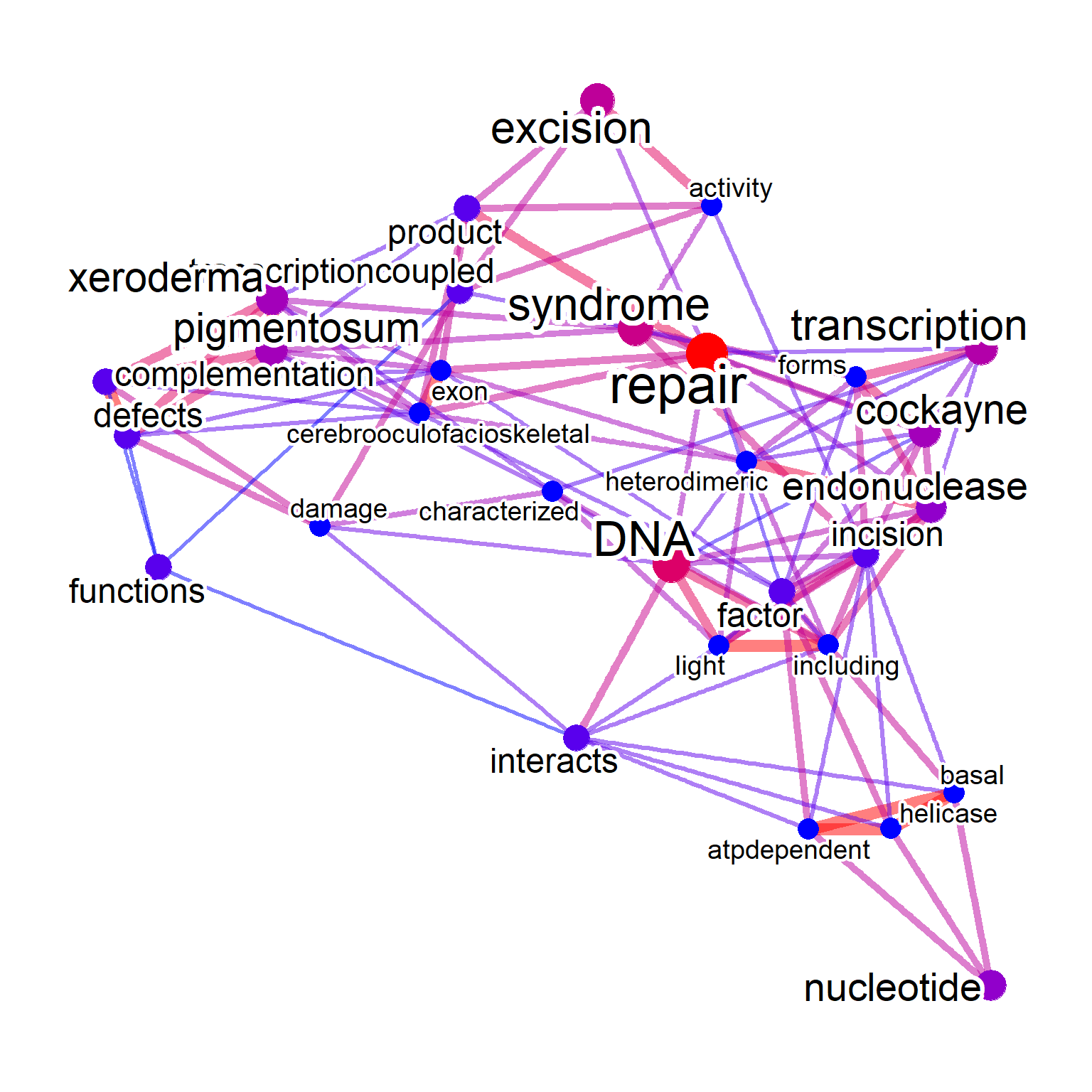 By default, the gene ID type is set to
By default, the gene ID type is set to SYMBOL. The other type can be set by keyType. As many of the words are commonly observed, filtering based on pre-computed word frequency on whole RefSeq data is provided. You should limit word frequency by excludeFreq, which is default to 2000. TF-IDF on the all the summary is also precomputed, and exclude="tfidf" can be specified too.
net <- refseq(inpSymbol, excludeFreq=1000)
#> Input genes: 7
#> Converted input genes: 7
#> Filter based on GeneSummary
#> Filtered 141 words (frequency and/or tfidf)
#> Ignoring corThresh, automatically determine the value
#> threshold = 0.519
plotNet(net, asis=TRUE)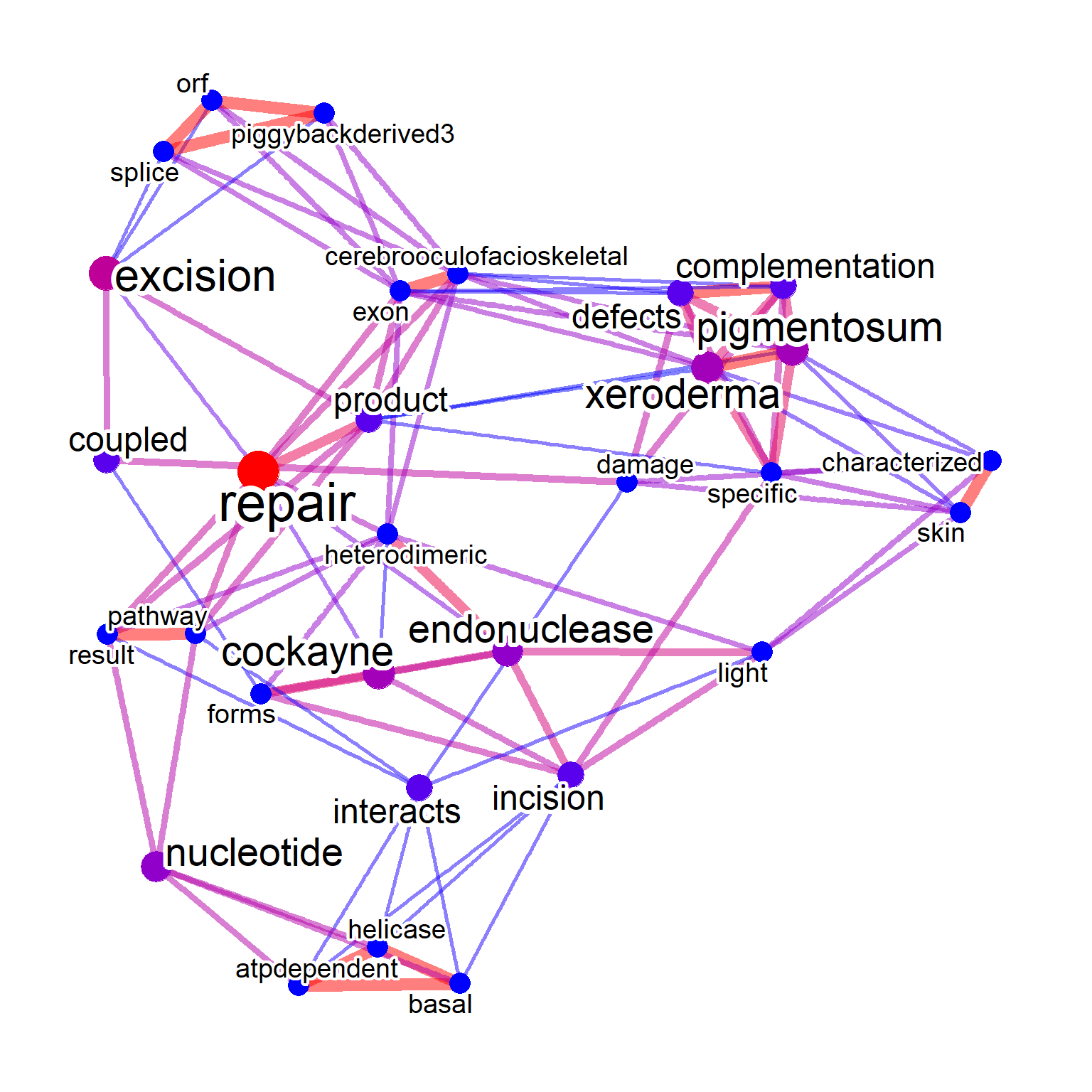
For visualization, The edge label corresponding to correlation or cooccurrence values can be shown by edgeLabel=TRUE. The number of words to be shown on plot can be specified by numWords. The threshold of correlation can be specified by corThresh. The visualized network layout can be specified by passing layout argument. The text color can be changed by colorText=TRUE. The type of edge can be specified by edgeLink, which is by default TRUE (link will be used).
net <- refseq(inpSymbol, plotType="network",
edgeLabel=TRUE, corThresh=0.4,
numWords=20, colorText=TRUE, layout="kk")
#> Input genes: 7
#> Converted input genes: 7
#> Filter based on GeneSummary
#> Filtered 77 words (frequency and/or tfidf)
#> Ignoring corThresh, automatically determine the value
#> threshold = 0.5
plotNet(net, asis=TRUE)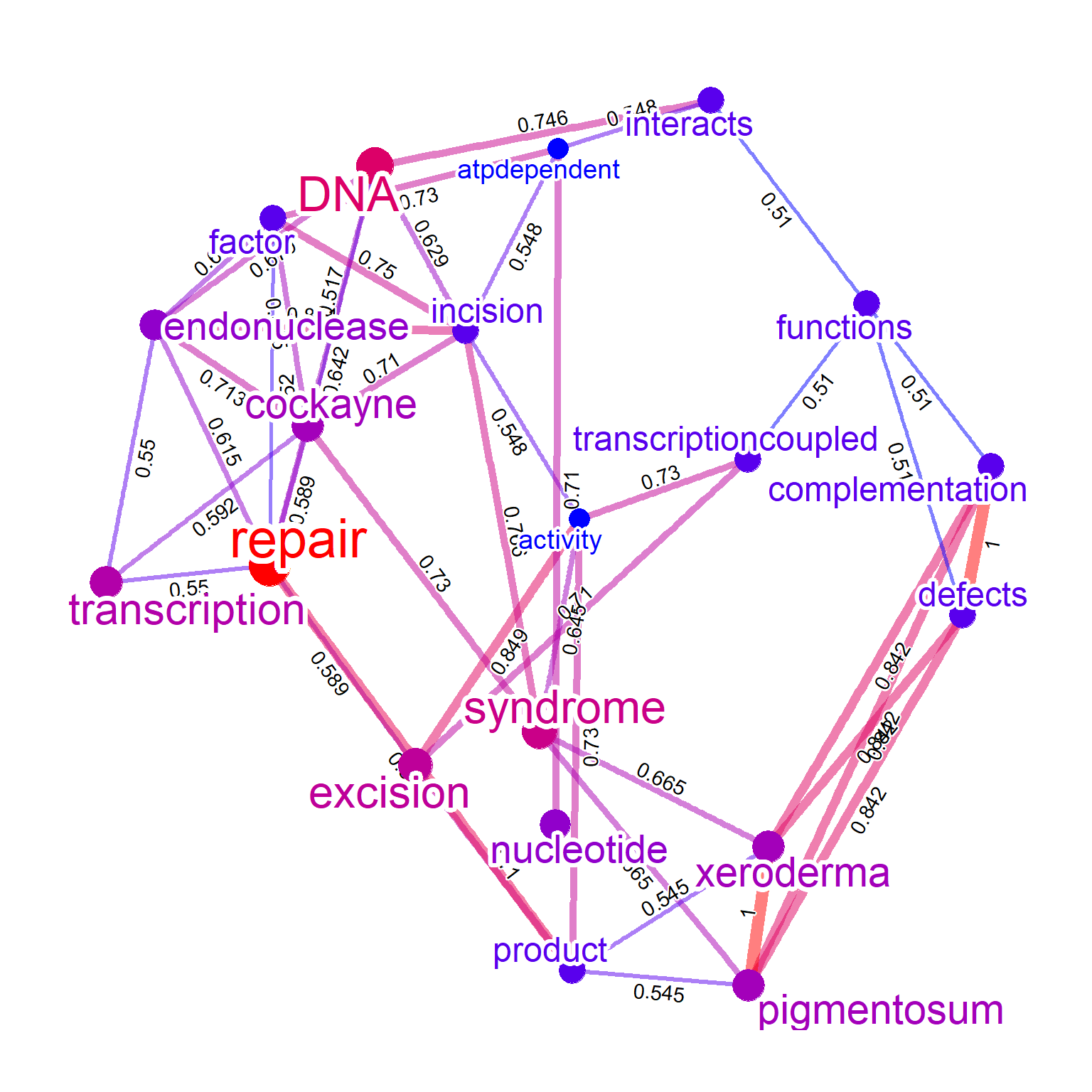 One of the main questions is which words can be clustered together among the words contained in the queried gene cluster. Word clustering (
One of the main questions is which words can be clustered together among the words contained in the queried gene cluster. Word clustering (pvclust) and identified significant clusters based on the occurrence in the text can be visualized by specifying tag="cor". For the significance threshold, pvclAlpha can be specified. The default parameters perform pvclust on the subset of dataset for words with high frequency specified by numWords. If one want to perform on whole matrix of TDM (which is a natural way), tagWhole=TRUE can be specified, although it is computationally intensive. One can pass clusters to perform parallel computing owning to pvclust function, by specifying cl as below. For tag coloring, tagPalette can be used. The igraph contained in the object can also be plotted by passing to plot method.
net <- refseq(inpSymbol, plotType="network", corThresh=0.2,
numWords=20, tag="correlation")
#> Input genes: 7
#> Converted input genes: 7
#> Filter based on GeneSummary
#> Filtered 77 words (frequency and/or tfidf)
#> Bootstrap (r = 0.5)... Done.
#> Bootstrap (r = 0.6)... Done.
#> Bootstrap (r = 0.7)... Done.
#> Bootstrap (r = 0.8)... Done.
#> Bootstrap (r = 0.9)... Done.
#> Bootstrap (r = 1.0)... Done.
#> Bootstrap (r = 1.1)... Done.
#> Bootstrap (r = 1.2)... Done.
#> Bootstrap (r = 1.3)... Done.
#> Bootstrap (r = 1.4)... Done.
#> Ignoring corThresh, automatically determine the value
#> threshold = 0.5
plotNet(net)
getSlot(net, "pvpick")
#> $clusters
#> $clusters[[1]]
#> [1] "pigmentosum" "xeroderma"
#>
#> $clusters[[2]]
#> [1] "activity" "atpdependent"
#> [3] "complementation" "defects"
#> [5] "factor" "functions"
#> [7] "incision" "interacts"
#> [9] "nucleotide" "product"
#> [11] "transcriptioncoupled"
#>
#> $clusters[[3]]
#> [1] "dna" "repair"
#>
#>
#> $edges
#> [1] 2 12 13
plot(net)
2.2 Identifying important genes in the network
The other important aim is finding important genes (queries) in the network. The genes associated with the words can be shown by specifying genePlot=TRUE, useful for assessing which words is associated with interesting genes. The edges connecting words to corresponding genes are shown.
One can specify genePlotNum for limiting the genes shown by ranking of how often a gene is associated with the high-frequency words. This can be useful for identifying important genes among the network.
net <- refseq(inpSymbol, plotType="network",
genePlot=TRUE, corThresh=0.5,
tag="correlation", edgeLink=FALSE,
numWords=20)
#> Input genes: 7
#> Converted input genes: 7
#> Filter based on GeneSummary
#> Filtered 77 words (frequency and/or tfidf)
#> Bootstrap (r = 0.5)... Done.
#> Bootstrap (r = 0.6)... Done.
#> Bootstrap (r = 0.7)... Done.
#> Bootstrap (r = 0.8)... Done.
#> Bootstrap (r = 0.9)... Done.
#> Bootstrap (r = 1.0)... Done.
#> Bootstrap (r = 1.1)... Done.
#> Bootstrap (r = 1.2)... Done.
#> Bootstrap (r = 1.3)... Done.
#> Bootstrap (r = 1.4)... Done.
#> Ignoring corThresh, automatically determine the value
#> threshold = 0.5
plotNet(net, asis=TRUE)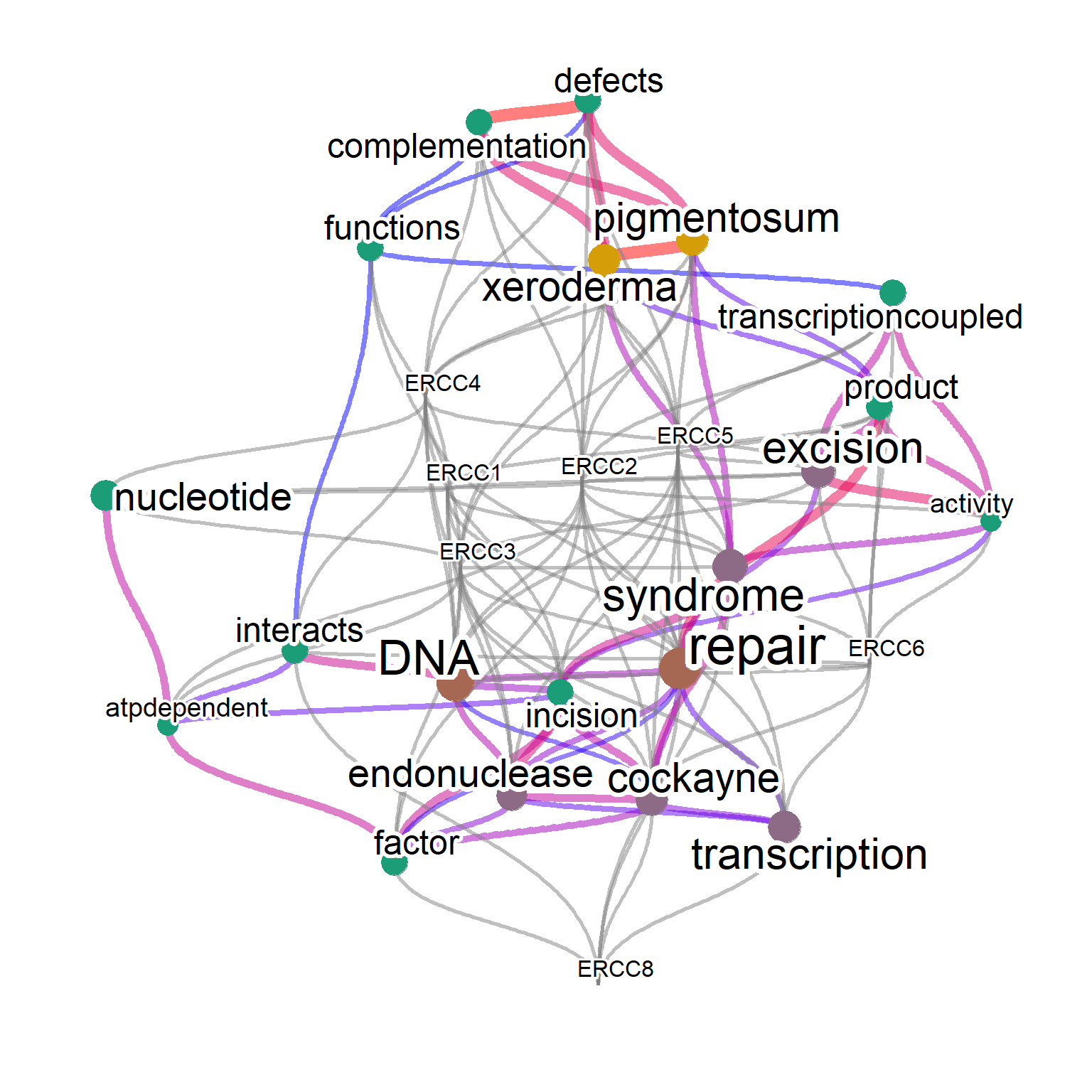
The associated enriched pathways (if present) can be shown by specifying genePathPlot, using ggforce. In this option, the function first performs over-representation analysis on the whole gene set, and plot enriched terms for included genes in the plot. Enrichment analysis here is performed by the library clusterProfiler or ReactomePA, and one can control which pathways to plot by genePathPlotSig value.
library(concaveman)
library(ggforce)
net <- refseq(inpSymbol, plotType="network",
genePathPlot="reactome", corThresh=0.5,
tag="correlation", edgeLink=FALSE,
genePathPlotSig=0.05, numWords=20)
#> Input genes: 7
#> Converted input genes: 7
#> Filter based on GeneSummary
#> Filtered 77 words (frequency and/or tfidf)
#> Bootstrap (r = 0.5)... Done.
#> Bootstrap (r = 0.6)... Done.
#> Bootstrap (r = 0.7)... Done.
#> Bootstrap (r = 0.8)... Done.
#> Bootstrap (r = 0.9)... Done.
#> Bootstrap (r = 1.0)... Done.
#> Bootstrap (r = 1.1)... Done.
#> Bootstrap (r = 1.2)... Done.
#> Bootstrap (r = 1.3)... Done.
#> Bootstrap (r = 1.4)... Done.
#> Found 48 enriched term
#> Ignoring corThresh, automatically determine the value
#> threshold = 0.5
plotNet(net, asis=TRUE)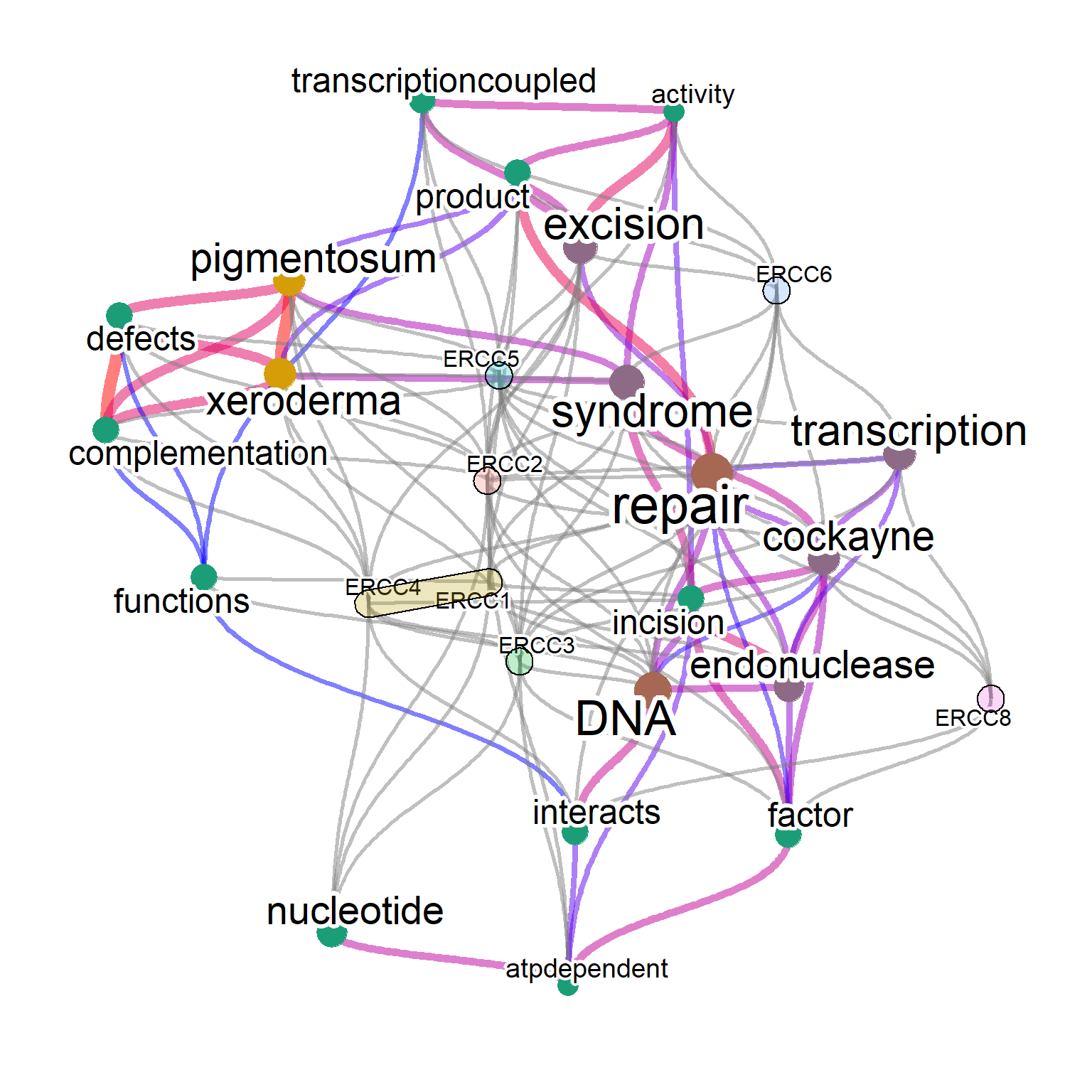
By default, the associated genes are plotted without colorization (grey) and without nodes. If preferred, set colorize=TRUE to colorize the associated genes by geneColor and showing the nodes by adding pseudo-frequency corresponding to the minimum frequency of words in the network. In this way, color of nodes corresponding to words are shown by the gradient of frequency, and the queried genes are shown by geneColor. addFreqToGene also adds pseudo-frequency to gene nodes and show the node, but are colorized according to the specified minimum frequency.
net <- refseq(inpSymbol, plotType="network",
genePlot=TRUE, corThresh=0.5,
colorize=TRUE, geneColor="pink",
colorText=TRUE,
tag="cor", edgeLink=FALSE,
numWords=20)
#> Input genes: 7
#> Converted input genes: 7
#> Filter based on GeneSummary
#> Filtered 77 words (frequency and/or tfidf)
#> Bootstrap (r = 0.5)... Done.
#> Bootstrap (r = 0.6)... Done.
#> Bootstrap (r = 0.7)... Done.
#> Bootstrap (r = 0.8)... Done.
#> Bootstrap (r = 0.9)... Done.
#> Bootstrap (r = 1.0)... Done.
#> Bootstrap (r = 1.1)... Done.
#> Bootstrap (r = 1.2)... Done.
#> Bootstrap (r = 1.3)... Done.
#> Bootstrap (r = 1.4)... Done.
#> Ignoring corThresh, automatically determine the value
#> threshold = 0.5
plotNet(net, asis=TRUE)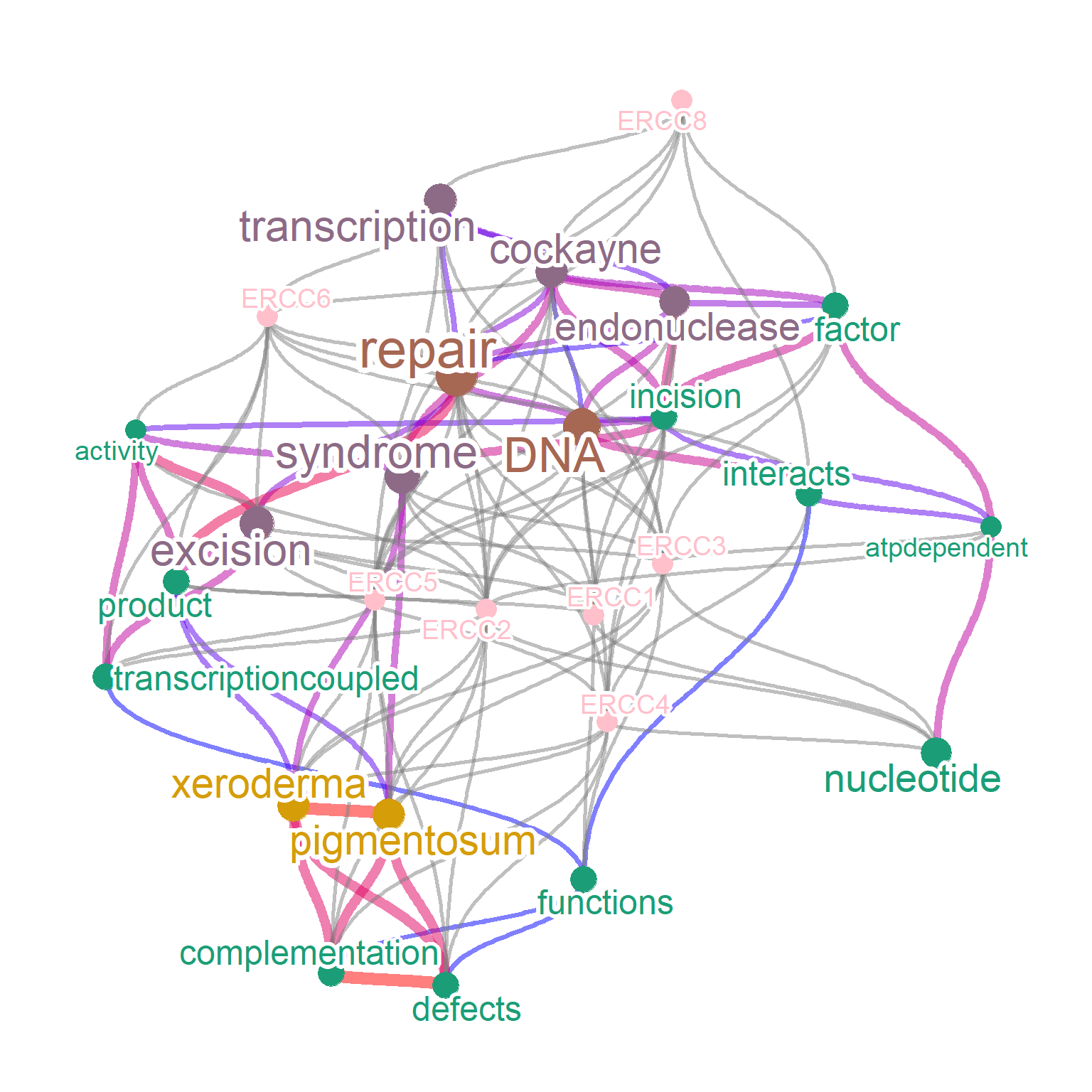
2.3 Producing word clouds
The other basic usage of the package is producing a word cloud of summaries of identifiers. Specify plotType="wc" or use plot_wordcloud() function for this purpose.
wc <- obtain_refseq(c("DDX41","PNKP","IRF3")) |> make_corpus() |> make_TDM() |> plot_wordcloud()
#> Input genes: 3
#> Converted input genes: 3
gwc <- refseq(inpSymbol, plotType="wc")
#> Input genes: 7
#> Converted input genes: 7
#> Filter based on GeneSummary
#> Filtered 77 words (frequency and/or tfidf)
plotWC(gwc, asis=TRUE)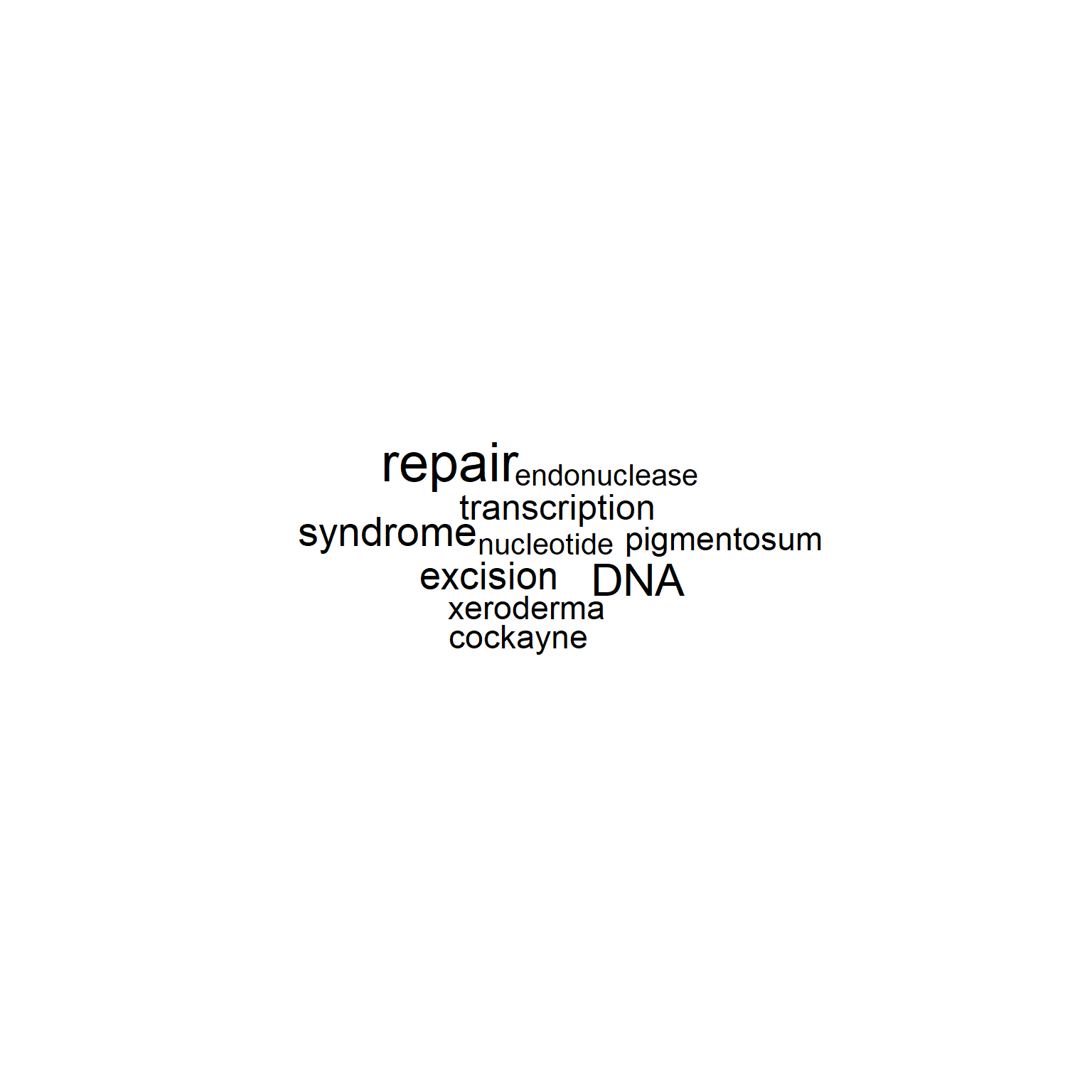
It accepts values of the wordcloud() function. numWords specifies how many words are to be shown on word cloud. The words are ordered by their frequency, and the subset of 1:numWords is used to downstream visualization. The arguments for wordcloud visualization must be passed to argList arguments as a list. scaleFreq can be specified to scale the frequency when the observation count is low.
gwc <- refseq(inpSymbol,
plotType="wc",
numWords=100,
scaleFreq=2,
excludeFreq=5000,
argList=list(
"random.order"=FALSE,
colors=RColorBrewer::brewer.pal(8, "Dark2"),
"rot.per"=0.4)
)
#> Input genes: 7
#> Converted input genes: 7
#> Filter based on GeneSummary
#> Filtered 30 words (frequency and/or tfidf)
plotWC(gwc, asis=TRUE)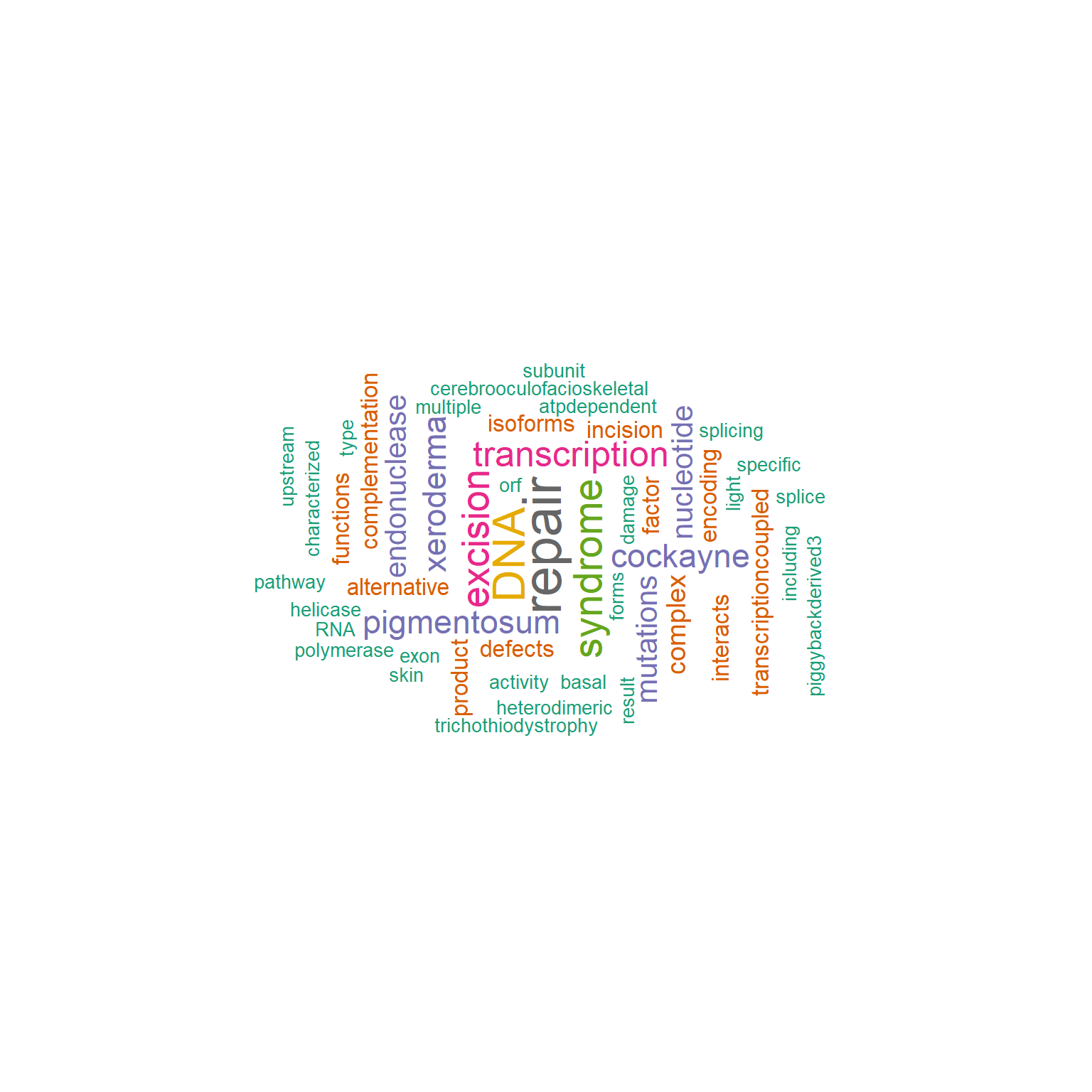
By default, preserve=TRUE, which indicates the funciton tries to preserve the original cases of characters. Note that if both the lower case words and capitalized words are present, all words are converted to capitalized words, like damage and Damage would be shown as Damage if preserve=TRUE.
gwc_p <- refseq(inpSymbol,
plotType="wc",
numWords=100,
excludeFreq=5000,
preserve=FALSE,
argList=list(
rot.per=0.4,
colors=RColorBrewer::brewer.pal(8, "Set2"),
random.order=FALSE)
)
#> Input genes: 7
#> Converted input genes: 7
#> Filter based on GeneSummary
#> Filtered 30 words (frequency and/or tfidf)
plotWC(gwc_p, asis=TRUE)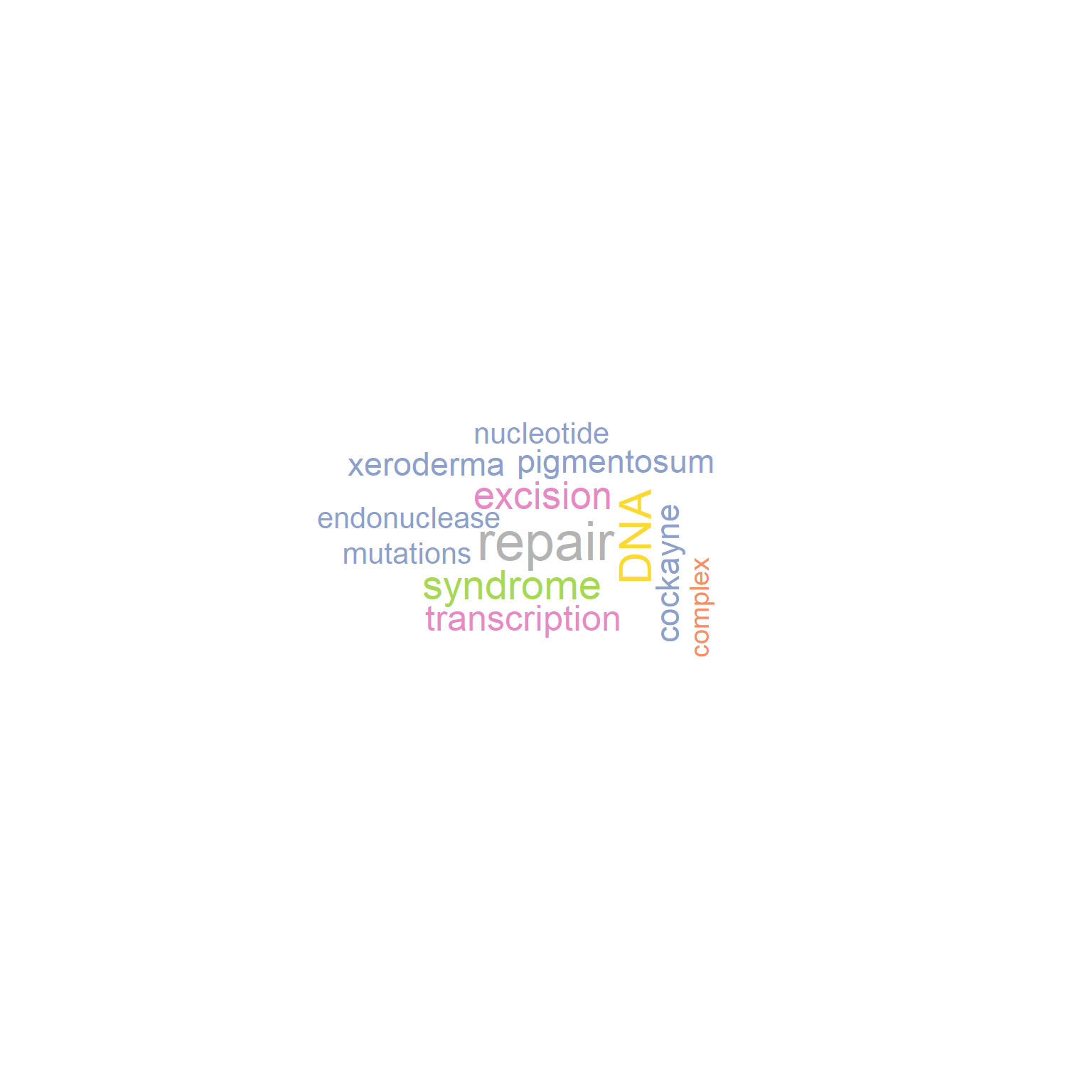
It also returns a data frame consisting of frequency of each term in the slot name freqDf.
gwc
#> Type: refseq
#> Number of words: 100
#> Query: ERCC1/ERCC2/ERCC3/ERCC4/ERCC5/ERCC6/ERCC8
#> 182.1 Kb
knitr::kable(
head(getSlot(gwc, "freqDf")),
caption = 'Term frequencies.',
row.names = FALSE
)| word | freq | wcColor |
|---|---|---|
| repair | 32 | black |
| DNA | 22 | black |
| syndrome | 18 | black |
| excision | 16 | black |
| transcription | 14 | black |
| cockayne | 12 | black |
N-gram is supported by library tm, specified by ngram.
Default is 1, and the example specifying 2 is shown below.
gwc2 <- refseq(inpSymbol,
ngram=2,
numWords=50,
plotType="wc",
scaleFreq=10,
argList=list(
rot.per=0.4,
colors=RColorBrewer::brewer.pal(8, "Set2"),
random.order=FALSE)
)
#> Input genes: 7
#> 'select()' returned 1:1 mapping between keys and
#> columns
#> Converted input genes: 7
#> Filter based on GeneSummary
#> Filtered 77 words (frequency and/or tfidf)
#> Scale for size is already present.
#> Adding another scale for size, which will replace the
#> existing scale.
plotWC(gwc2, asis=TRUE)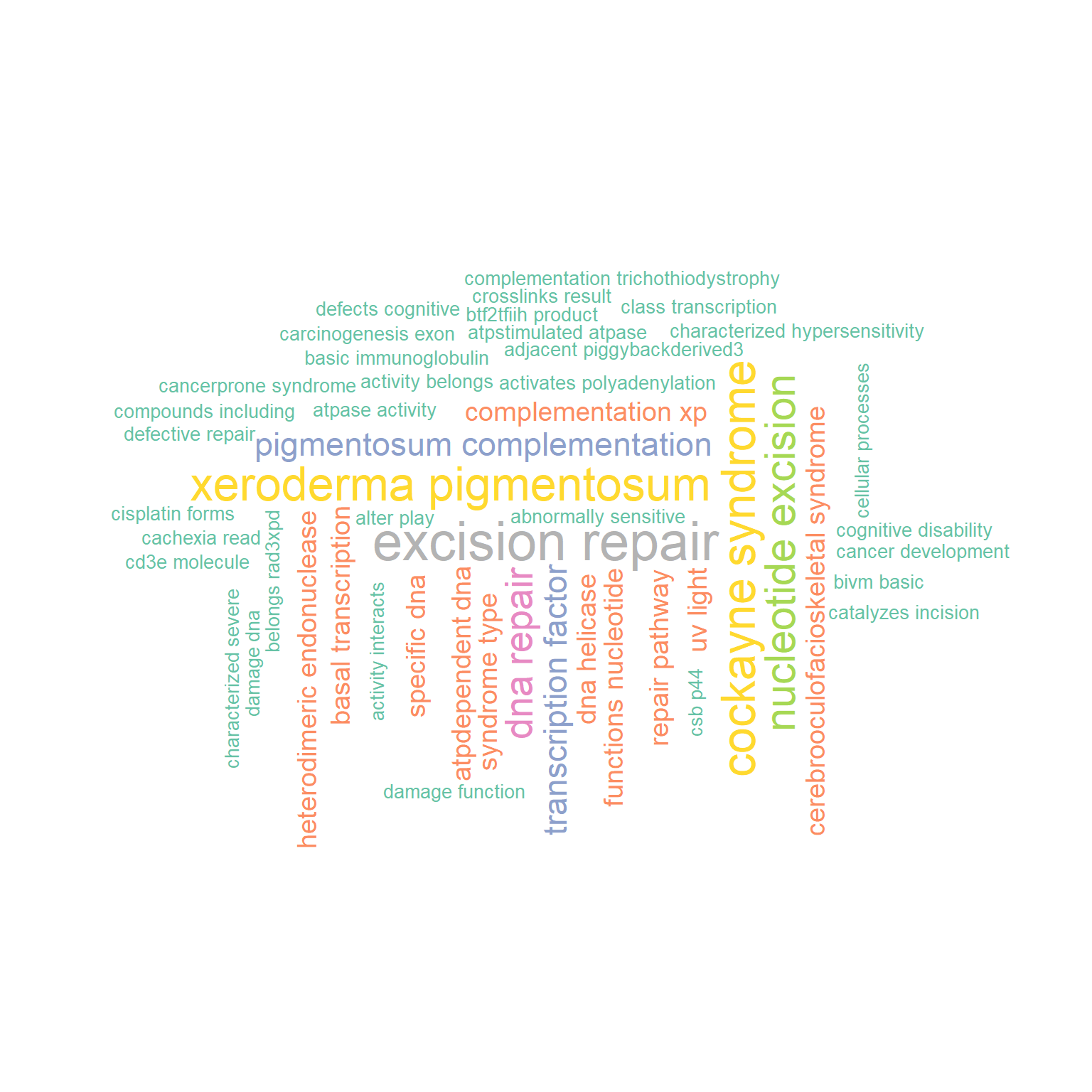
Using clusterProfiler functions, one can use enriched pathway names for visualization.
The enrich option can be specified for 'kegg' or 'reactome', this time we specify 'reactome'.
gwc3 <- refseq(inpSymbol,
plotType="wc", scaleFreq=10,
enrich="reactome")
#> Input genes: 7
#> 'select()' returned 1:1 mapping between keys and
#> columns
#> Converted input genes: 7
#> Performing enrichment analysis
#> Filter based on GeneSummary
#> Filtered 77 words (frequency and/or tfidf)
#> Scale for size is already present.
#> Adding another scale for size, which will replace the
#> existing scale.
plotWC(gwc3, argList=list("min.freq"=1))
#> Scale for size is already present.
#> Adding another scale for size, which will replace the
#> existing scale.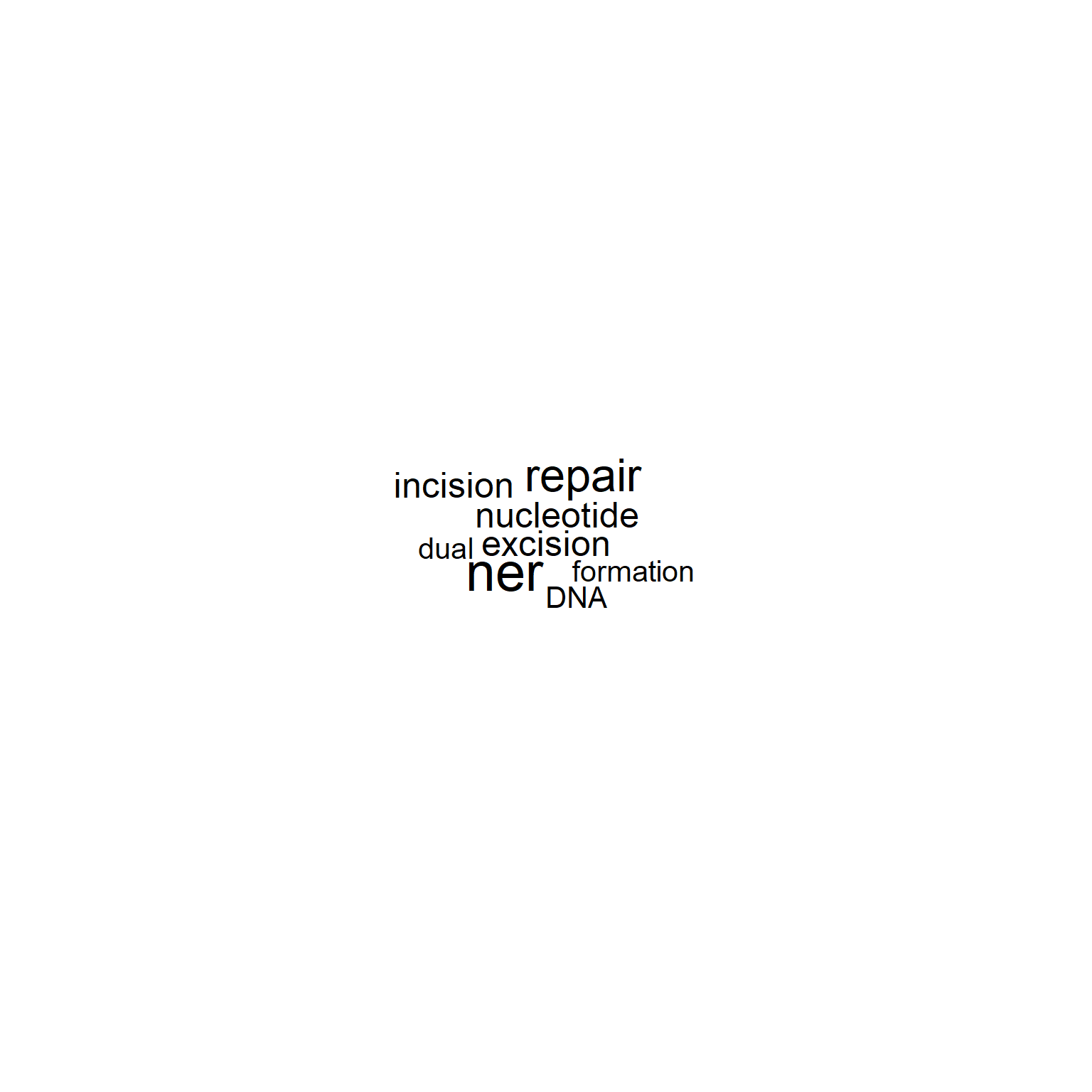
In the word cloud, it is also possible to visualize tag information with colors. In the example below, clustering was performed for all matrices, and the results were visualized based on the colors of tagPalette.
## Prepare the palette for tag coloring
pal <- RColorBrewer::brewer.pal(8, "Dark2")
pal <- colorRampPalette(pal)(20)
## Cluster on whole matrix
gwclWhole <- refseq(inpSymbol,
numWords=50,
plotType="wc",
tag="cor",
tagPalette = pal,
scaleFreq=5,
cl=snow::makeCluster(8),
argList=list(rot.per=0.4)
)
#> Input genes: 7
#> 'select()' returned 1:1 mapping between keys and
#> columns
#> Converted input genes: 7
#> Filter based on GeneSummary
#> Filtered 77 words (frequency and/or tfidf)
#> Multiscale bootstrap... Done.
#> Scale for size is already present.
#> Adding another scale for size, which will replace the
#> existing scale.
getSlot(gwclWhole, "pvpick")
#> $clusters
#> $clusters[[1]]
#> [1] "pigmentosum" "xeroderma"
#>
#> $clusters[[2]]
#> [1] "dna" "repair"
#>
#> $clusters[[3]]
#> [1] "abnormally" "activates"
#> [3] "active" "activity"
#> [5] "adjacent" "alter"
#> [7] "atpase" "atpdependent"
#> [9] "atpstimulated" "basal"
#> [11] "basic" "belongs"
#> [13] "bivm" "cerebrooculofacioskeletal"
#> [15] "characterized" "complementation"
#> [17] "damage" "defects"
#> [19] "exon" "factor"
#> [21] "forms" "functions"
#> [23] "helicase" "heterodimeric"
#> [25] "incision" "including"
#> [27] "interacts" "light"
#> [29] "nucleotide" "orf"
#> [31] "pathway" "piggybackderived3"
#> [33] "product" "result"
#> [35] "skin" "specific"
#> [37] "splice" "transcriptioncoupled"
#> [39] "trichothiodystrophy" "type"
#> [41] "upstream"
#>
#>
#> $edges
#> [1] 16 41 43
plotWC(gwclWhole, asis=TRUE)
In this example querying ERCC genes, the term DNA repair is clustered as expected.
2.3.1 Plotting associated genes in WC
By using the feature label_content in ggwordcloud, the user can choose to plot associated gene names along with the words, by genePlot=TRUE, as same as the network.
geneplotWC <- refseq(inpSymbol,
numWords=50,
plotType="wc",
tag="cor",
genePlot=TRUE,
tagPalette = pal,
scaleFreq=5,
cl=snow::makeCluster(8),
argList=list(rot.per=0.4)
)
#> Input genes: 7
#> 'select()' returned 1:1 mapping between keys and
#> columns
#> Converted input genes: 7
#> Filter based on GeneSummary
#> Filtered 77 words (frequency and/or tfidf)
#> 'select()' returned 1:1 mapping between keys and
#> columns
#> Multiscale bootstrap... Done.
#> Scale for size is already present.
#> Adding another scale for size, which will replace the
#> existing scale.
plotWC(geneplotWC, asis=TRUE)
#> Warning in wordcloud_boxes(data_points =
#> points_valid_first, boxes = boxes, : One word could not fit
#> on page. It has been removed.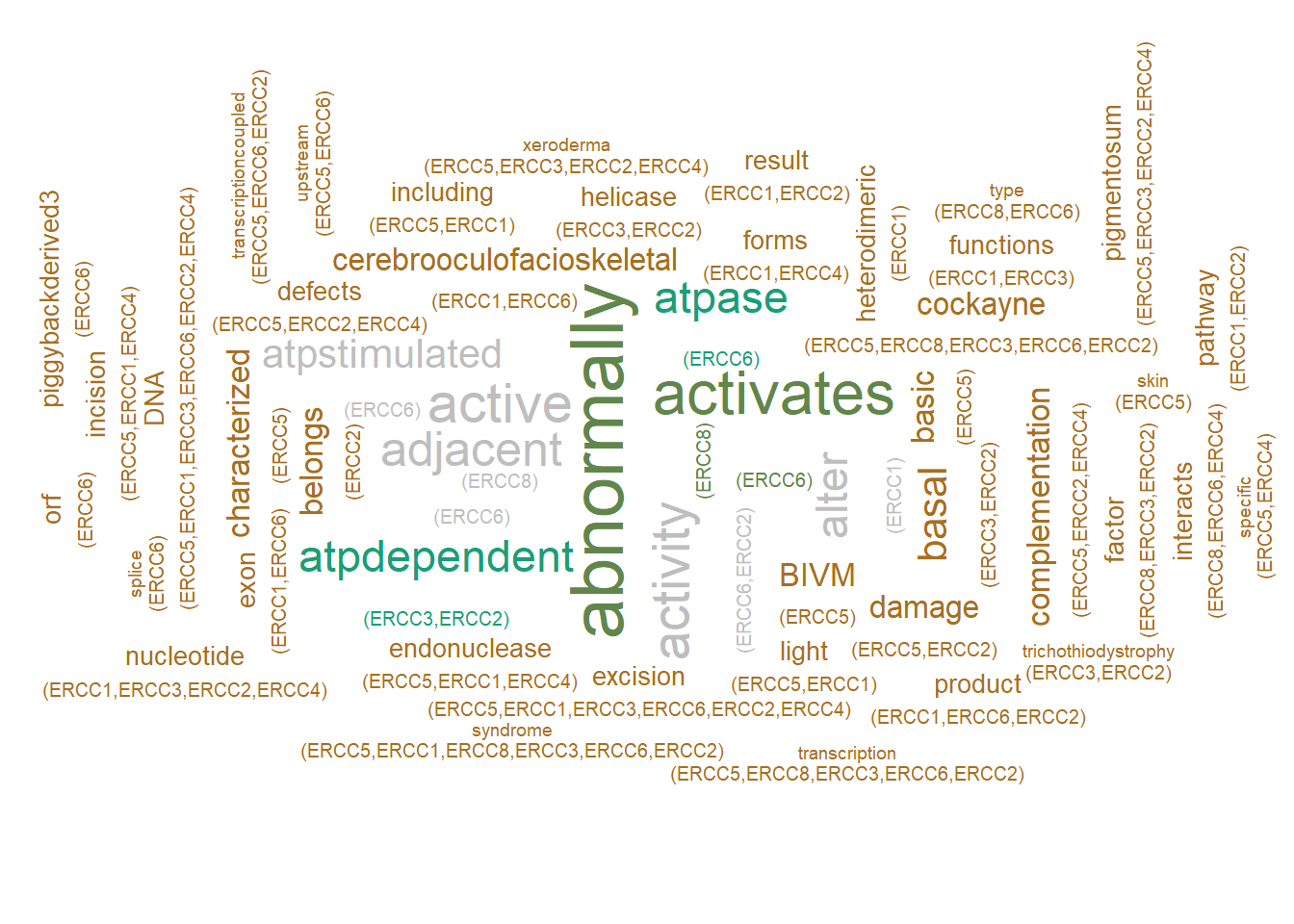
2.4 Visualization of PubMed information.
Using rentrez, one can perform the same analysis on PubMed text like the article title and abstract. The function queries for the input gene symbols (or the other queries) and visualize. For typical use cases, the genes identified by showing genePlot, or hub genes identified in gene network analysis can be queried. The basic parameters for searching PubMed, like max number of articles retrieved and how to sort the articles can be specified by retMax and sortOrder. Be sure to obtain an api key when querying heavily, and specify in apiKey argument. These functions including pubmed and refseq serve as wrappers for several other functions, but a detailed explanation can be found in 11.
ab <- pubmed(inpSymbol[1:3], retMax=20, apiKey=apiKey, plotType="wc")
#> Scale for size is already present.
#> Adding another scale for size, which will replace the
#> existing scale.
plotWC(ab, asis=TRUE)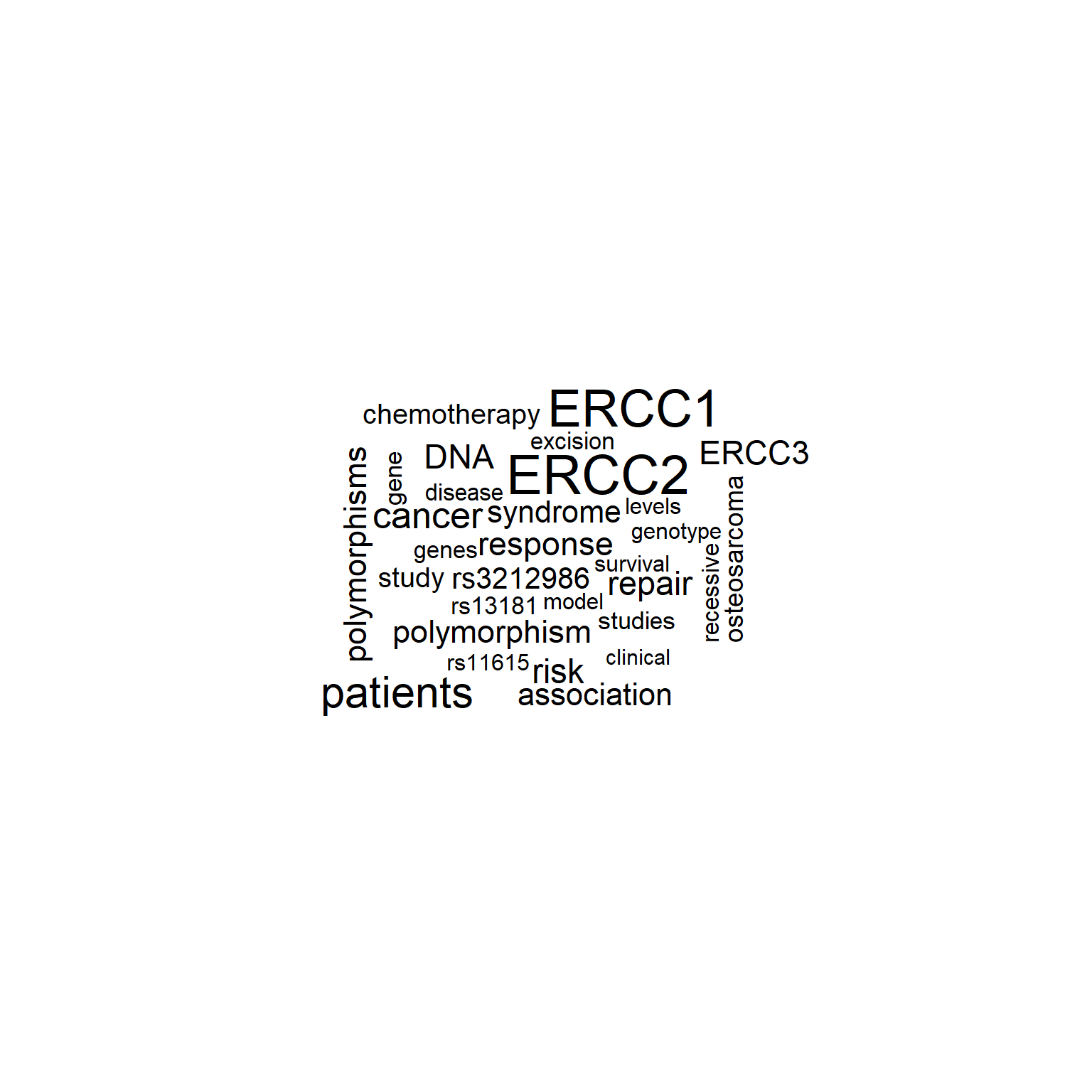
The returned PubMed IDs are stored in pmids slot.
As fetching the same information is not desirable and time consuming, the same object can be passed to redo option and re-perform the analysis like tagging, or changing the visualization options. Also, using obtain_pubmed function, only the text can be obtained and be processed by the downstream functions.
abtag <- pubmed(redo=ab, tag="cor", cl=snow::makeCluster(10), apiKey=apiKey)
#> Resuming from the previous results
#> Multiscale bootstrap... Done.
#> Ignoring corThresh, automatically determine the value
#> threshold = 0.3
abtag2 <- pubmed(redo=abtag, tag="cor", genePlot=TRUE,
plotType="network", corThresh=0.2, pre=TRUE, apiKey=apiKey)
#> Resuming from the previous results
#> Using previous pvclust resultsIgnoring corThresh, automatically determine the value
#> threshold = 0.201
plotNet(abtag2, asis=TRUE)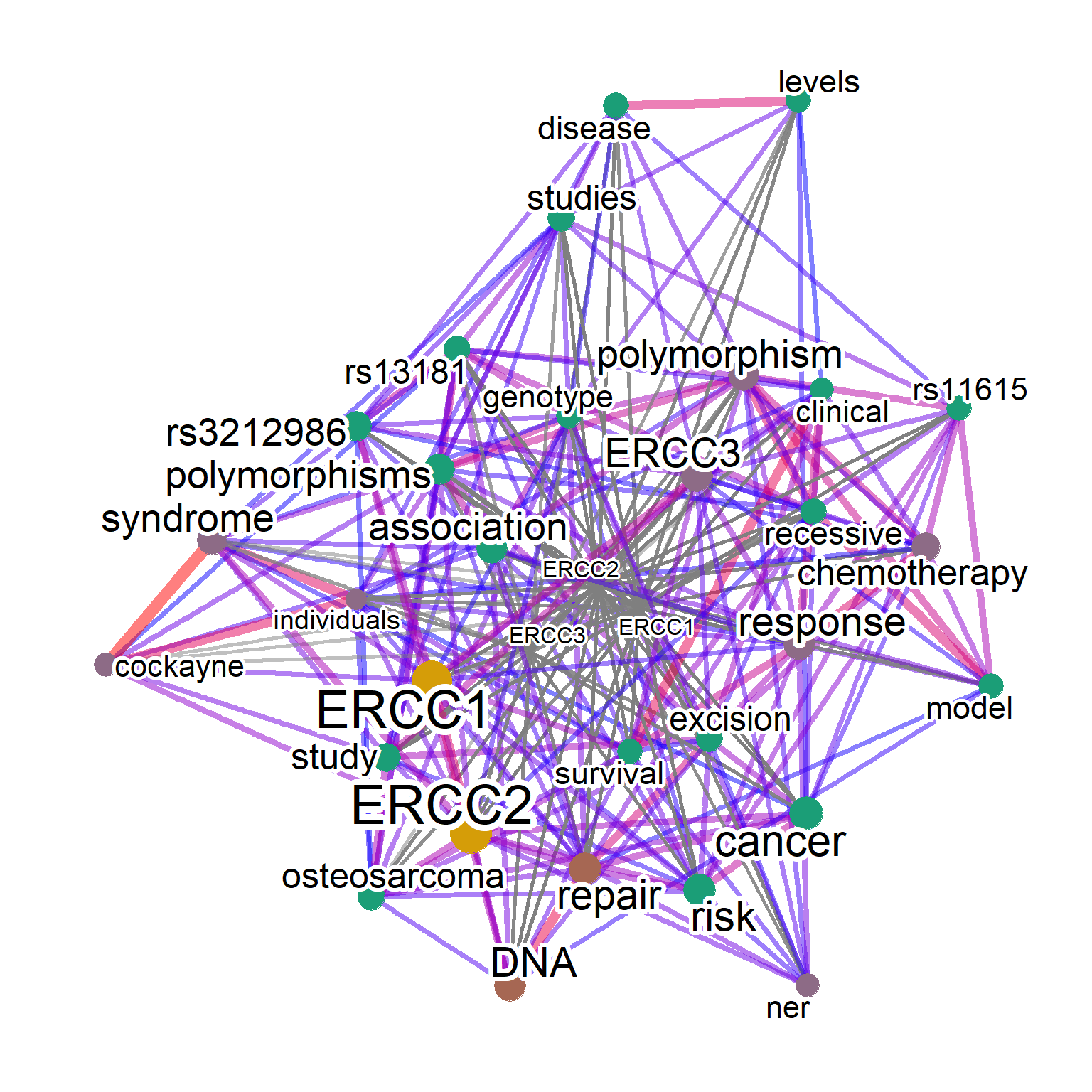
It is sometimes the case that the results of the search is dominated by one well-investigated or well-characterized genes (such as TP53).
To overcome this, the perQuery option can be specified to search the database one by one. It is recommended to use API key for querying a large number of genes. Here, we use onlyGene option to plot only the gene symbols.
netPerQuery <- pubmed(inpSymbol[1:5], perQuery=TRUE, onlyGene=TRUE, apiKey=apiKey, numWords=150)
#> Querying ERCC1
#> Querying ERCC2
#> Querying ERCC3
#> Querying ERCC4
#> Querying ERCC5
#> Ignoring corThresh, automatically determine the value
#> threshold = 0.3
#> Subsetting to the gene symbol in orgDb
plotNet(netPerQuery, asis=TRUE)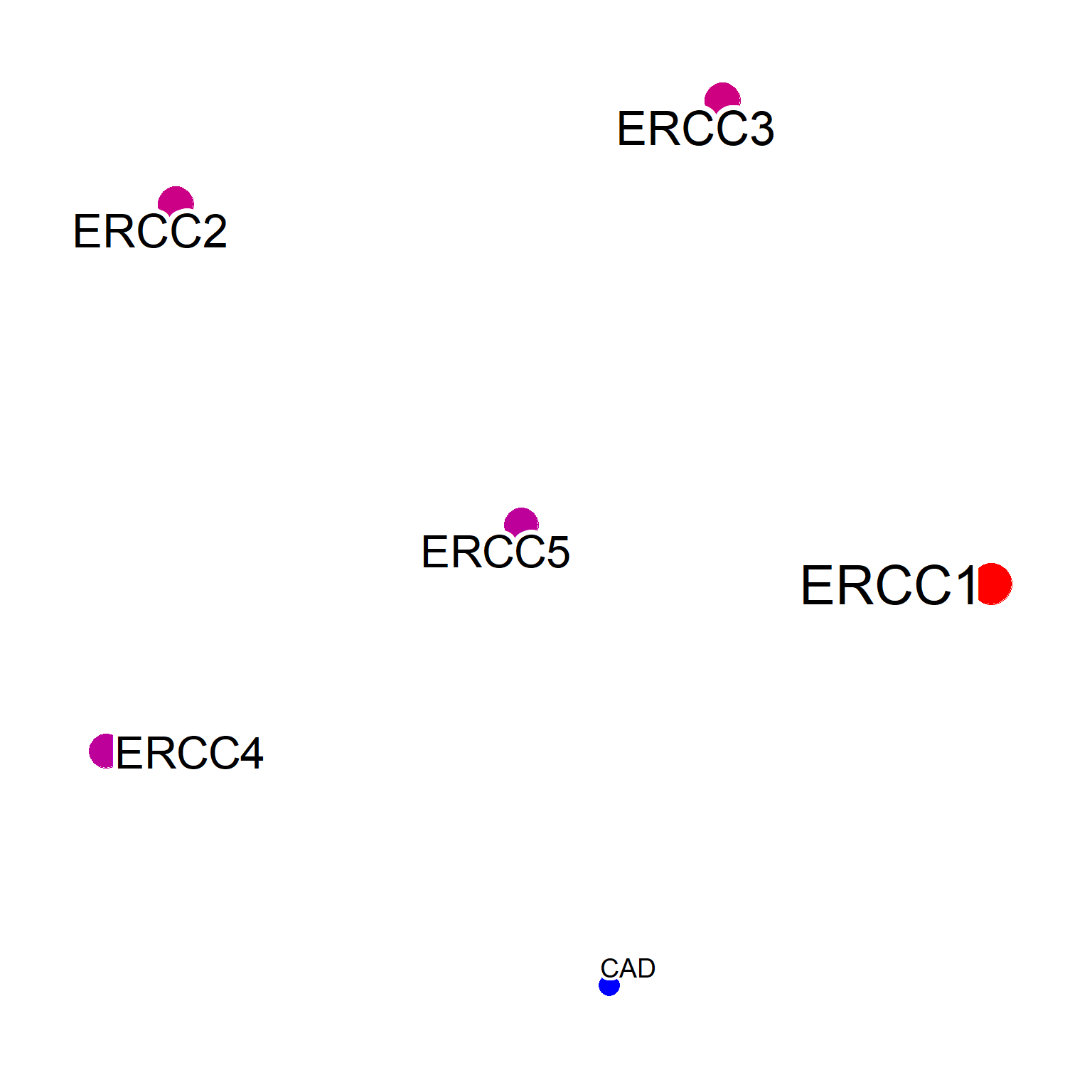
2.5 Comparing two or more networks
One can compare two or more networks by providing list of biotext objects produced by text mining various databases, like refseq, pubmed, obtain_refseq, etc. This can be useful for assessing the similarity and dissimilarity of the various text sources, like PubMed, RefSeq, and Reactome pathway names. Additionally, performing graph-based clustering on merged networks can potentially identify groups of related terms within the overall network.
cxcls <- c()
for (i in c(1,2,3,5,6,8,9,10,11,12,13,14,16)){
cxcls <- c(cxcls, paste0("CXCL",i))
}
net1 <- refseq(inpSymbol, plotType="network",
corThresh=0.5, numWords=20)
#> Input genes: 7
#> Converted input genes: 7
#> Filter based on GeneSummary
#> Filtered 77 words (frequency and/or tfidf)
#> Ignoring corThresh, automatically determine the value
#> threshold = 0.5
net2 <- refseq(cxcls, plotType="network",
corThresh=0.5, numWords=20)
#> Input genes: 13
#> Converted input genes: 13
#> Filter based on GeneSummary
#> Filtered 77 words (frequency and/or tfidf)
#> Ignoring corThresh, automatically determine the value
#> threshold = 0.4
net3 <- pubmed(redo=ab, plotType="network",
corThresh=0.2, numWords=20)
#> Resuming from the previous results
#> Ignoring corThresh, automatically determine the value
#> threshold = 0.3
## Not having meaningful overlaps
compareWordNet(list(net1, net2),
titles=c("ercc","cxcl")) |> plotNet()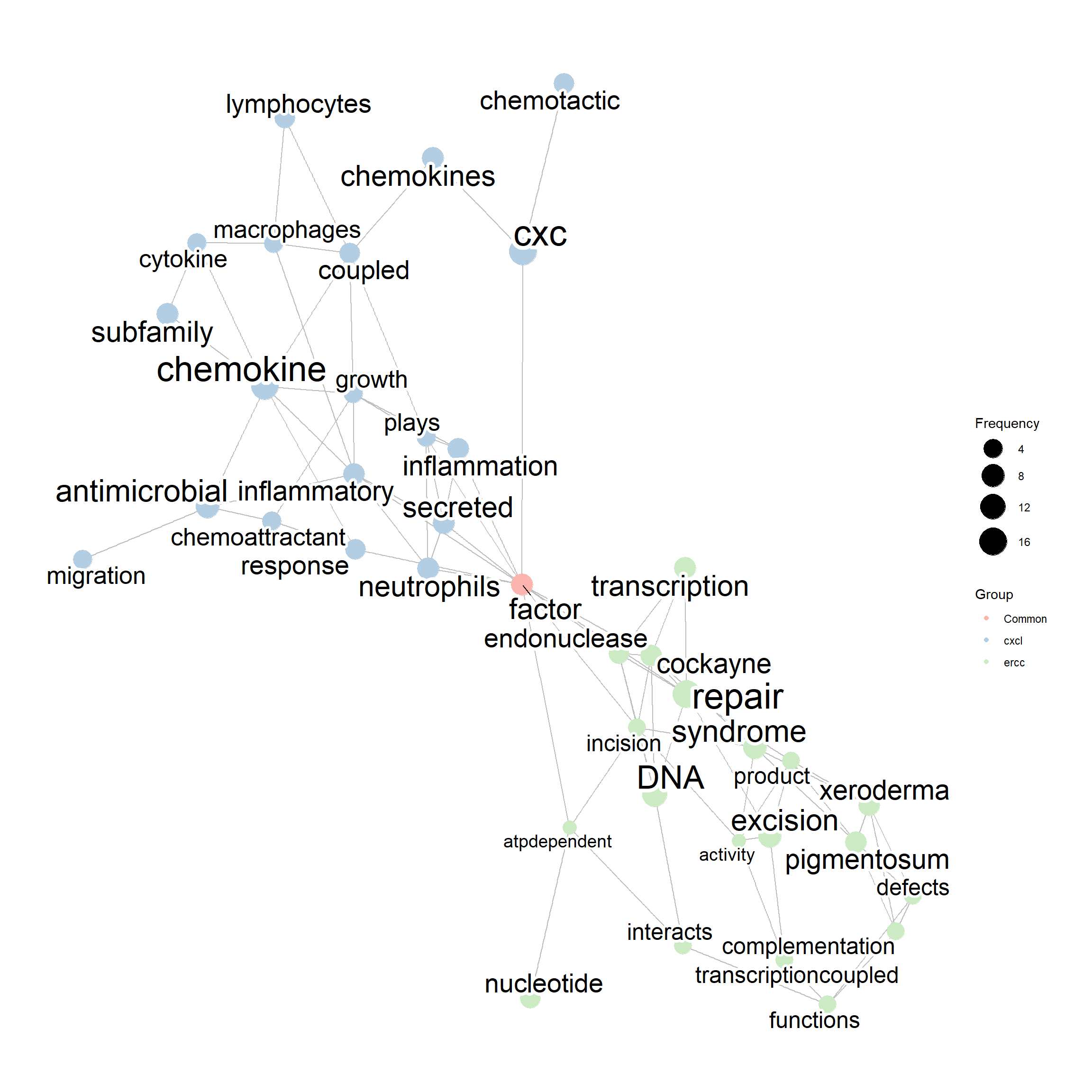
compareWordNet(list(net1, net3),
titles=c("ercc","ercc-PubMed")) |> plotNet()
compareWordNet(list(net1, net2, net3),
titles=c("ercc","cxcl", "ercc-PubMed")) |> plotNet()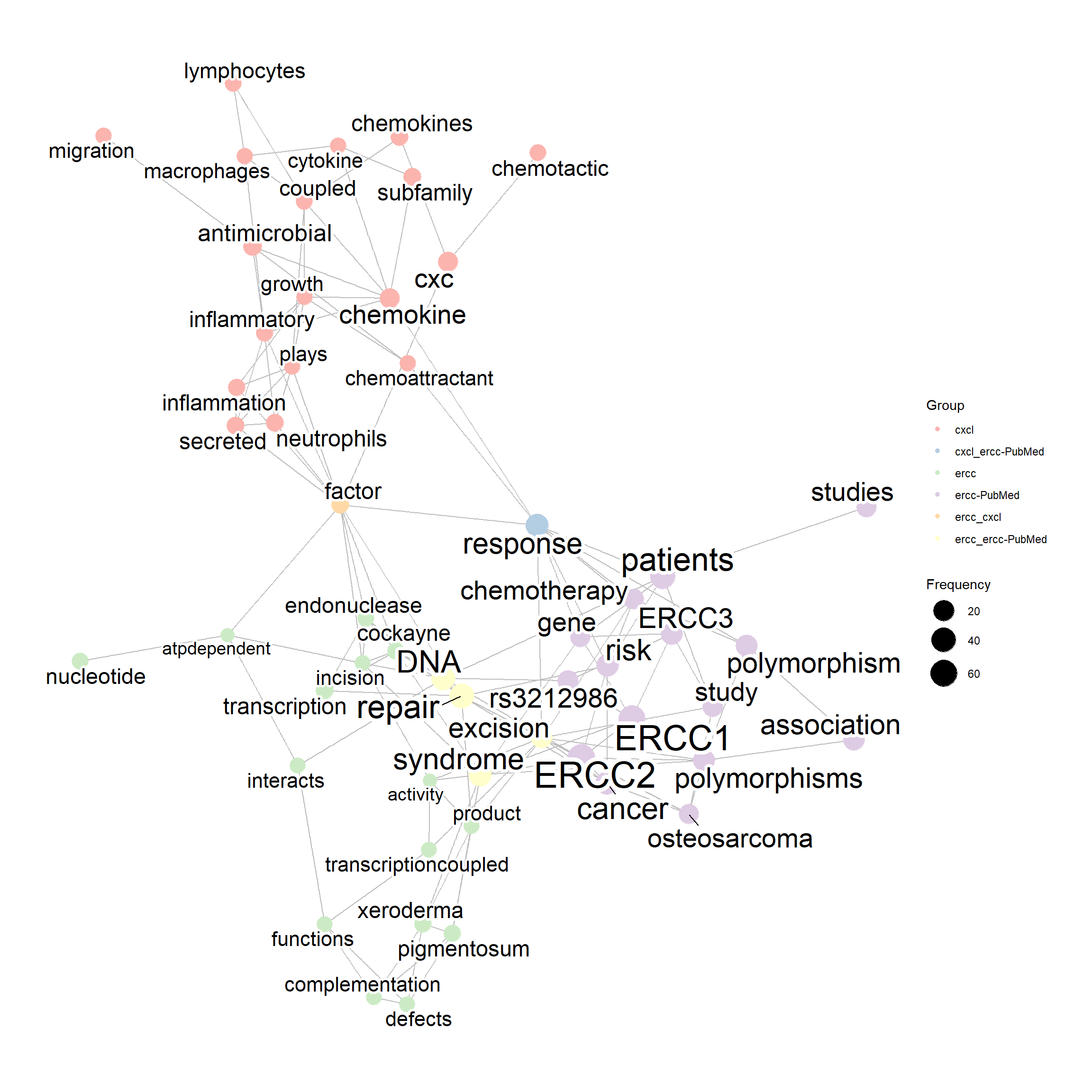
If tag information is available in both gene clusters, combined tags can be visualized by tag=TRUE. If using geom_mark_hull to show the tagging information, specify hull=TRUE in compareWordNet.
keggPathways <- org.Hs.egPATH2EG
mappedKeys <- mappedkeys(keggPathways)
keggList <- as.list(keggPathways[mappedKeys])
net1 <- refseq(keggList$`04110`,
keyType="ENTREZID",
corThresh=0.3,
numWords=30,
tag="cor",
tfidf=TRUE)
#> Input genes: 124
#> Filter based on GeneSummary
#> Filtered 77 words (frequency and/or tfidf)
#> Bootstrap (r = 0.5)... Done.
#> Bootstrap (r = 0.6)... Done.
#> Bootstrap (r = 0.7)... Done.
#> Bootstrap (r = 0.8)... Done.
#> Bootstrap (r = 0.9)... Done.
#> Bootstrap (r = 1.0)... Done.
#> Bootstrap (r = 1.1)... Done.
#> Bootstrap (r = 1.2)... Done.
#> Bootstrap (r = 1.3)... Done.
#> Bootstrap (r = 1.4)... Done.
#> Ignoring corThresh, automatically determine the value
#> threshold = 0.1
net2 <- refseq(keggList$`04210`,
keyType="ENTREZID",
corThresh=0.3,
numWords=30,
tfidf=TRUE,
tag="cor")
#> Input genes: 87
#> Filter based on GeneSummary
#> Filtered 77 words (frequency and/or tfidf)
#> Bootstrap (r = 0.5)... Done.
#> Bootstrap (r = 0.6)... Done.
#> Bootstrap (r = 0.7)... Done.
#> Bootstrap (r = 0.8)... Done.
#> Bootstrap (r = 0.9)... Done.
#> Bootstrap (r = 1.0)... Done.
#> Bootstrap (r = 1.1)... Done.
#> Bootstrap (r = 1.2)... Done.
#> Bootstrap (r = 1.3)... Done.
#> Bootstrap (r = 1.4)... Done.
#> Ignoring corThresh, automatically determine the value
#> threshold = 0.1
compareWordNet(list(net1, net2), tag=TRUE, hull=TRUE) |> plotNet()
An application example of using text mining for transcriptome analysis of BK polyomavirus infection by combining the functions described here 9.
2.6 Text over represenatation analysis (experimental)
For RefSeq, overrepresentation-based filtering and prioritization of words can be performed using pre-computed background.
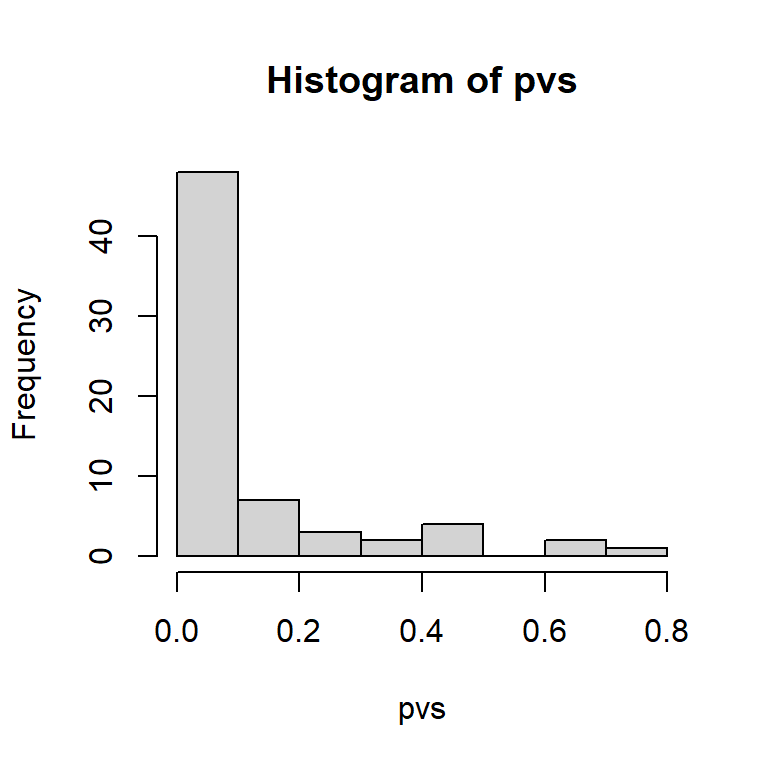
pvs[order(pvs)] |> head()
#> lipoic step acid
#> 1.600963e-14 8.016934e-08 5.300425e-07
#> lipoateactivating lipoatedependent lipoyl
#> 1.484931e-04 1.484931e-04 1.484931e-04
geneList <- keggList$`05150` # Staphylococcus aureus infection
pvs <- textORA(geneList)
hist(pvs)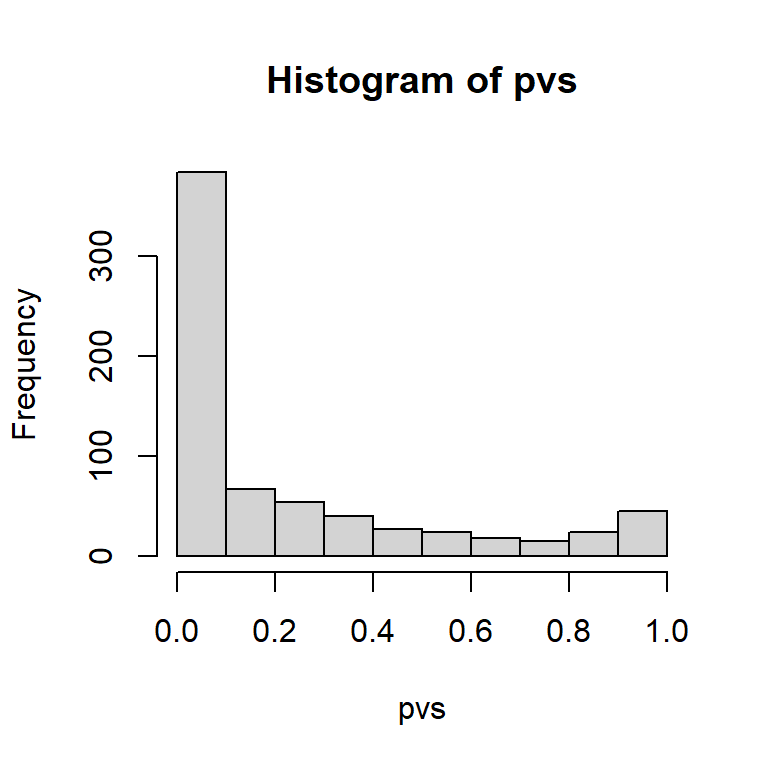
pvs[order(pvs)] |> head()
#> drb chain complement class
#> 0.000000e+00 3.669590e-82 3.266180e-74 5.496543e-46
#> exon beta
#> 6.851722e-39 1.318324e-34This thresholding can be used in RefSeq visualization in the above functions.
Filter words using ORA threshold and frequency threshold by setting ora=TRUE.
net <- refseq(inpSymbol, plotType="network",
ora=TRUE, edgeLink=FALSE)
#> Input genes: 7
#> Converted input genes: 7
#> Filter based on GeneSummary
#> Filtered 77 words (frequency and/or tfidf)
#> Performing ORA
#> Filtered 148 words (ORA)
#> Ignoring corThresh, automatically determine the value
#> threshold = 0.5
plotNet(net, asis=TRUE)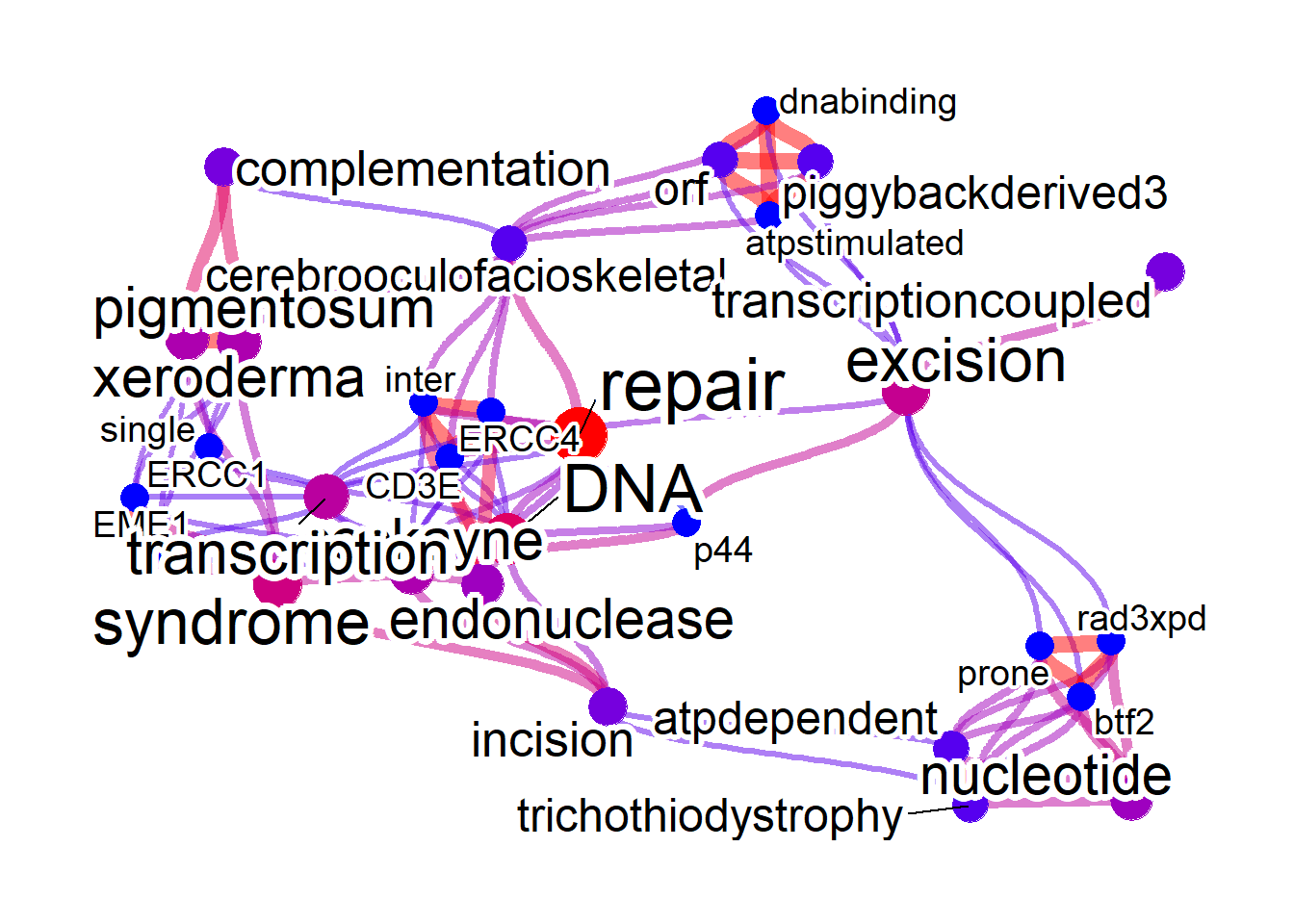
After obtaining the ORA results, one can plot volcano-plot like plot for the results using plotORA function.
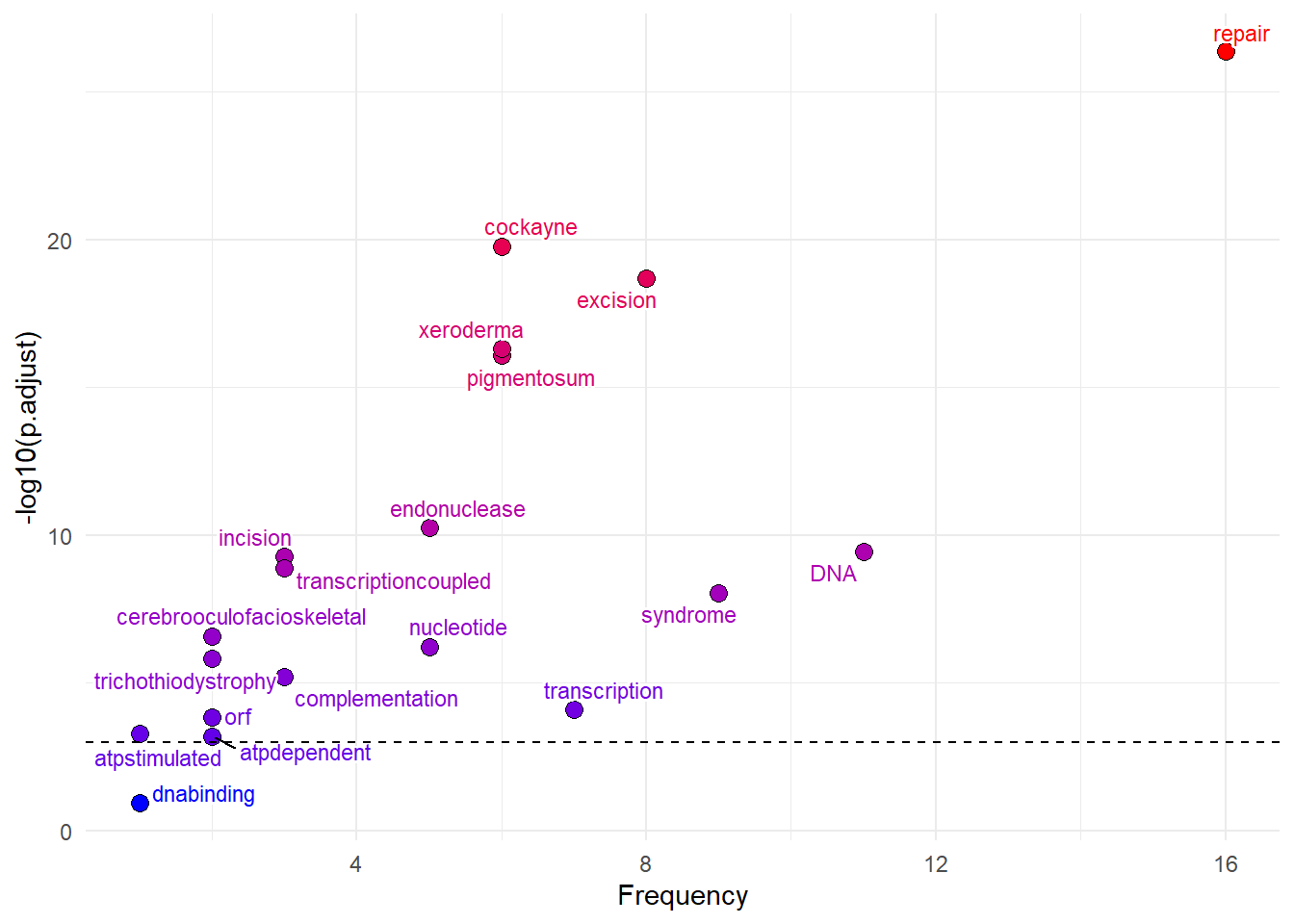
2.7 Dependency analyis using udpipe
Using udpipe package (Straka and Straková. 2017), one can performe dependency analysis of texts in various databases. Set useUdpipe to TRUE, and specify downloaded model to be used in udpipeModel.
p <- biotextgraph::refseq(c("DDX41","PNKP","ERCC2"),
plotType="network", useUdpipe=TRUE,
udpipeModel="english-ewt-ud-2.5-191206.udpipe")
#> Using udpipe mode
#> Input genes: 3
#> Converted input genes: 3
#> Filter based on GeneSummary
#> Filtered 77 words (frequency and/or tfidf)
plotNet(p, asis=TRUE)
2.8 Changing the font
Font can be specified by fontFamily, which affects all the labels including edges and nodes.
load(system.file("extdata", "sysdata.rda", package = "biotextgraph"))
degs <- d3degUpAssetta2016
## Use alien encounter fonts (http://www.hipsthetic.com/alien-encounters-free-80s-font-family/)
sysfonts::font_add(family="alien",regular="SFAlienEncounters.ttf")
p <- biotextgraph::refseq(degs,
plotType="network",
numWords=50, genePlot=TRUE,
fontFamily="alien", autoThresh=FALSE,
colorText=TRUE)
#> Input genes: 636
#> Converted input genes: 552
#> Filter based on GeneSummary
#> Filtered 77 words (frequency and/or tfidf)
plotNet(p, asis=TRUE)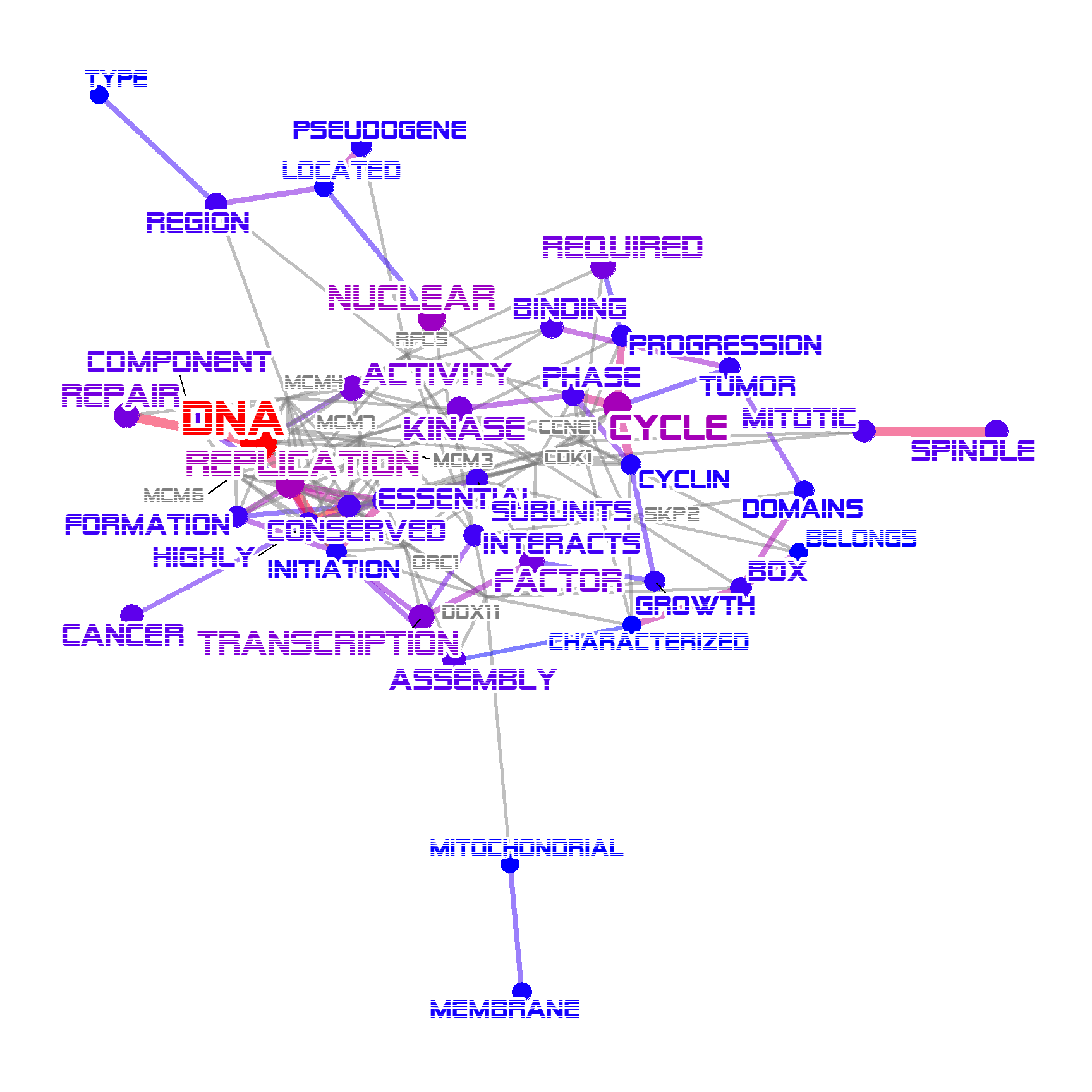
For complex networks, changing the layout is possible by the small function changeLayout.
Specify which layout algorithm to choose in igraph. This can be also accomplished by specifying the layout in plotNet method.
changeLayout(p, igraph::layout.graphopt) |> plotNet(asis=TRUE)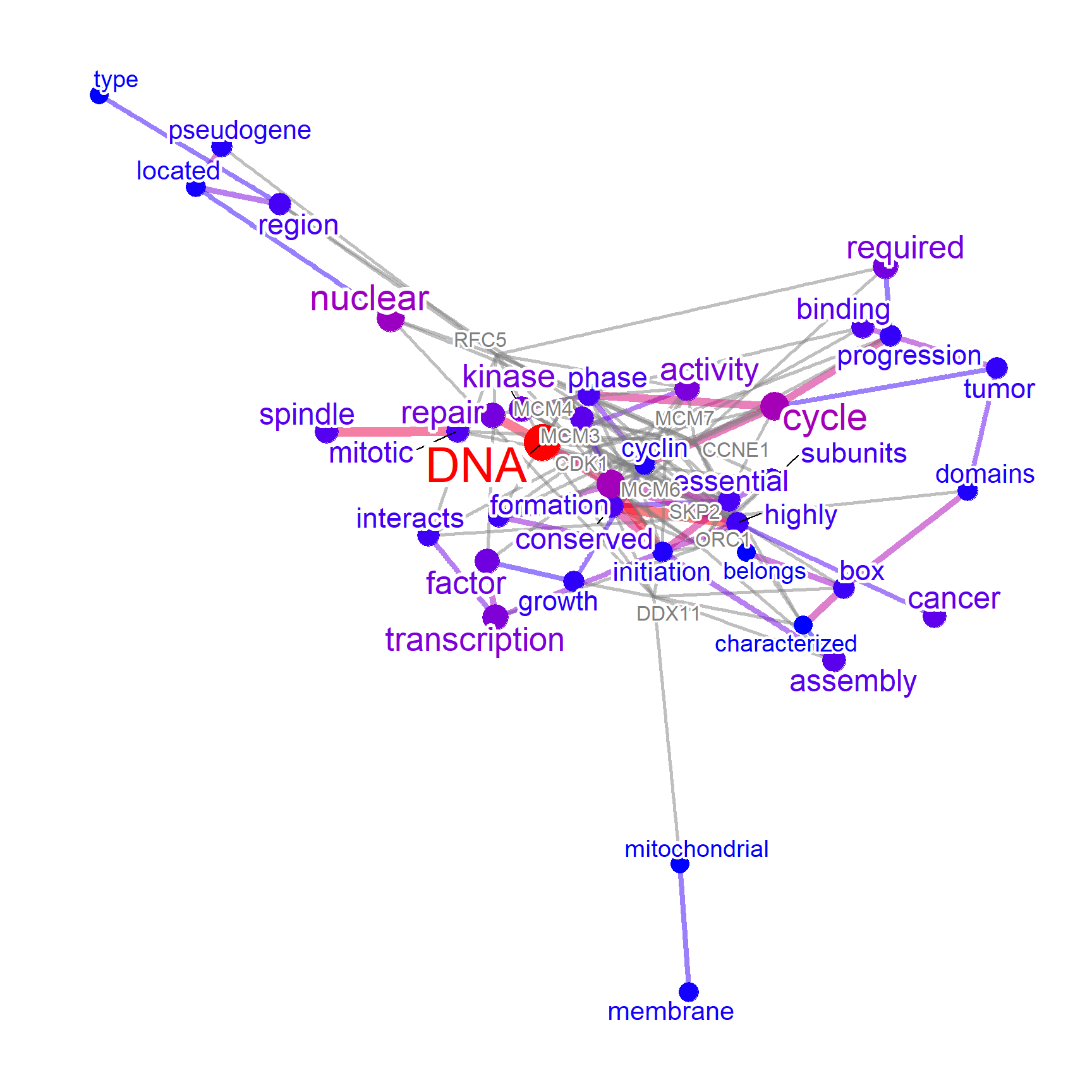
2.9 Biofabric layout
It is possible to use the BioFabric layout from the extracted igraph. In this case, one wants to add text position in x-axis using biotextgraph::obtainTextPosition. For the beautiful BioFabric layout, please refer to their original homepage here, and their publication available here (Longabaugh, W.J. 2012).
ex <- refseq(c("DDX41","PNKP"), autoThresh=FALSE, genePlot=TRUE)
#> Input genes: 2
#> Converted input genes: 2
#> Filter based on GeneSummary
#> Filtered 77 words (frequency and/or tfidf)
ex <- getSlot(ex, "igraph") |> obtainTextPosition() ## Obtain text position for the X-axis
ex |>
ggraph("fabric",
sort.by = node_rank_fabric())+
geom_node_range() +
geom_edge_span(end_shape = 'circle') +
geom_node_text(aes(x=xmin-4, label=name), size=2.5)+
shadowtext::geom_shadowtext(aes(x=center,
color=nodeCat, y=y+1, label=name),
size=2.5, bg.colour="white")+
scale_color_manual(values=c("grey20", "grey80"))+
theme_graph()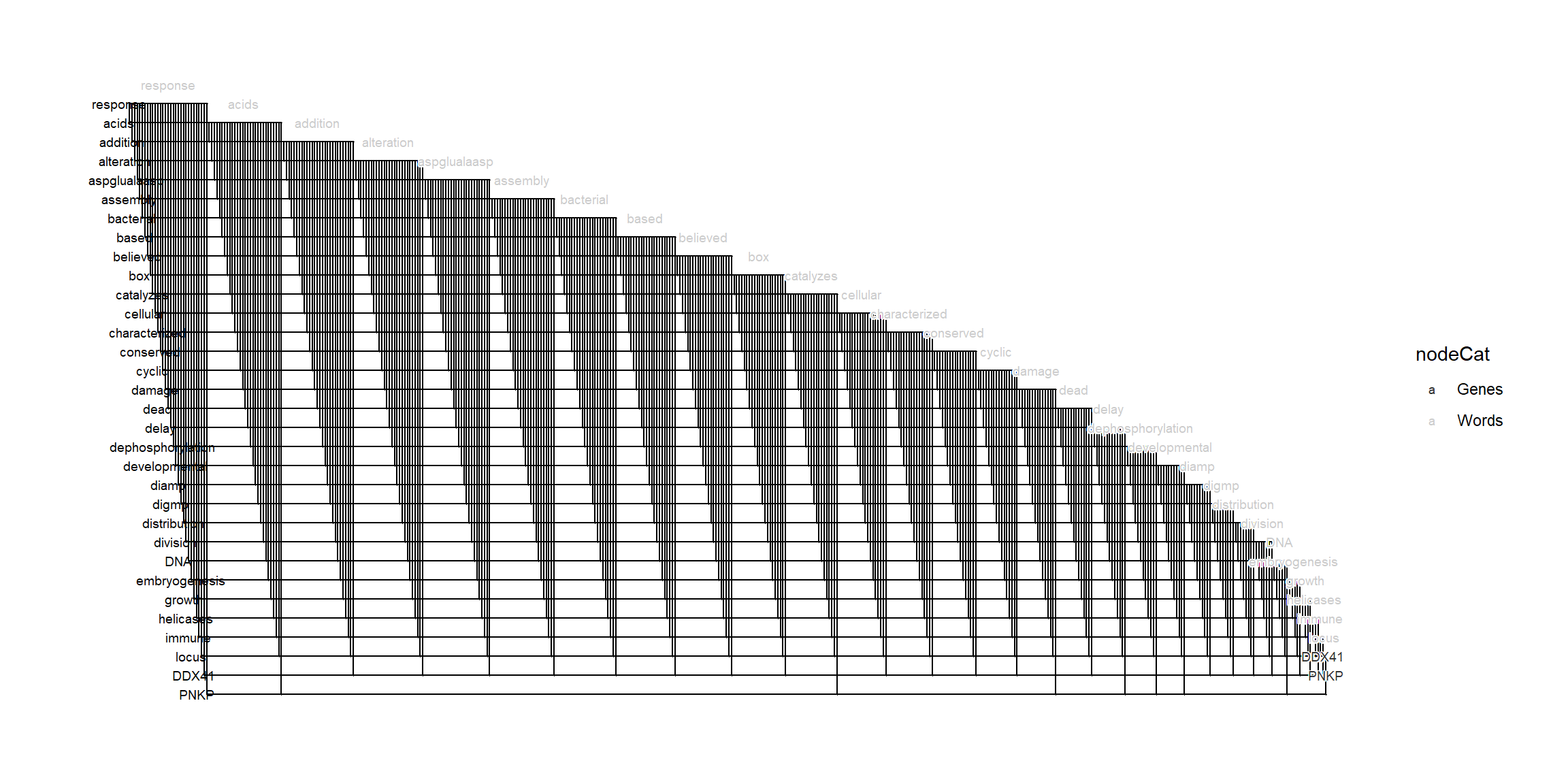
2.9.1 Highlighting genes in the layout
For more practical use, we highlight gene names in the layout using ggfx.
library(ggfx)
# Use sample DEGs
ex <- suppressMessages(refseq(d3degUpAssetta2016,
genePlot=TRUE,
numWords=50,
preserve=FALSE,
autoThresh=FALSE))
#> Input genes: 636
#> Converted input genes: 552
#> Filter based on GeneSummary
#> Filtered 77 words (frequency and/or tfidf)
# Obtain text positions, and plot using various geoms.
getSlot(ex, "igraph") |> obtainTextPosition(verbose=FALSE) |>
ggraph("fabric", sort.by = node_rank_fabric())+
geom_node_range(aes(color=nodeCat)) +
geom_edge_span(end_shape = 'circle') +
with_outer_glow(ggkegg::geom_node_shadowtext(aes(x=xmin-4, label=name, filter=type=="Genes"), size=2.5,
color="tomato", bg.colour="white"), "gold",expand=5)+ ## Show genes (shadowtext + ggfx)
geom_node_text(aes(x=xmin-4, label=name, filter=type!="Genes"), size=2)+
ggkegg::geom_node_shadowtext(aes(x=center, size=xmin, filter=type!="Genes", color=nodeCat, y=y+1, label=name), bg.colour="white")+
with_outer_glow(ggkegg::geom_node_shadowtext(aes(x=center, filter=type=="Genes", color=nodeCat, y=y+1, label=name),
size=2.5, bg.colour="white"),"gold",expand=5)+
scale_color_manual(values=c("tomato", "grey20"),name="Category")+
theme_graph() +
scale_size(trans = 'reverse', range=c(1.5,2))+
guides(size="none")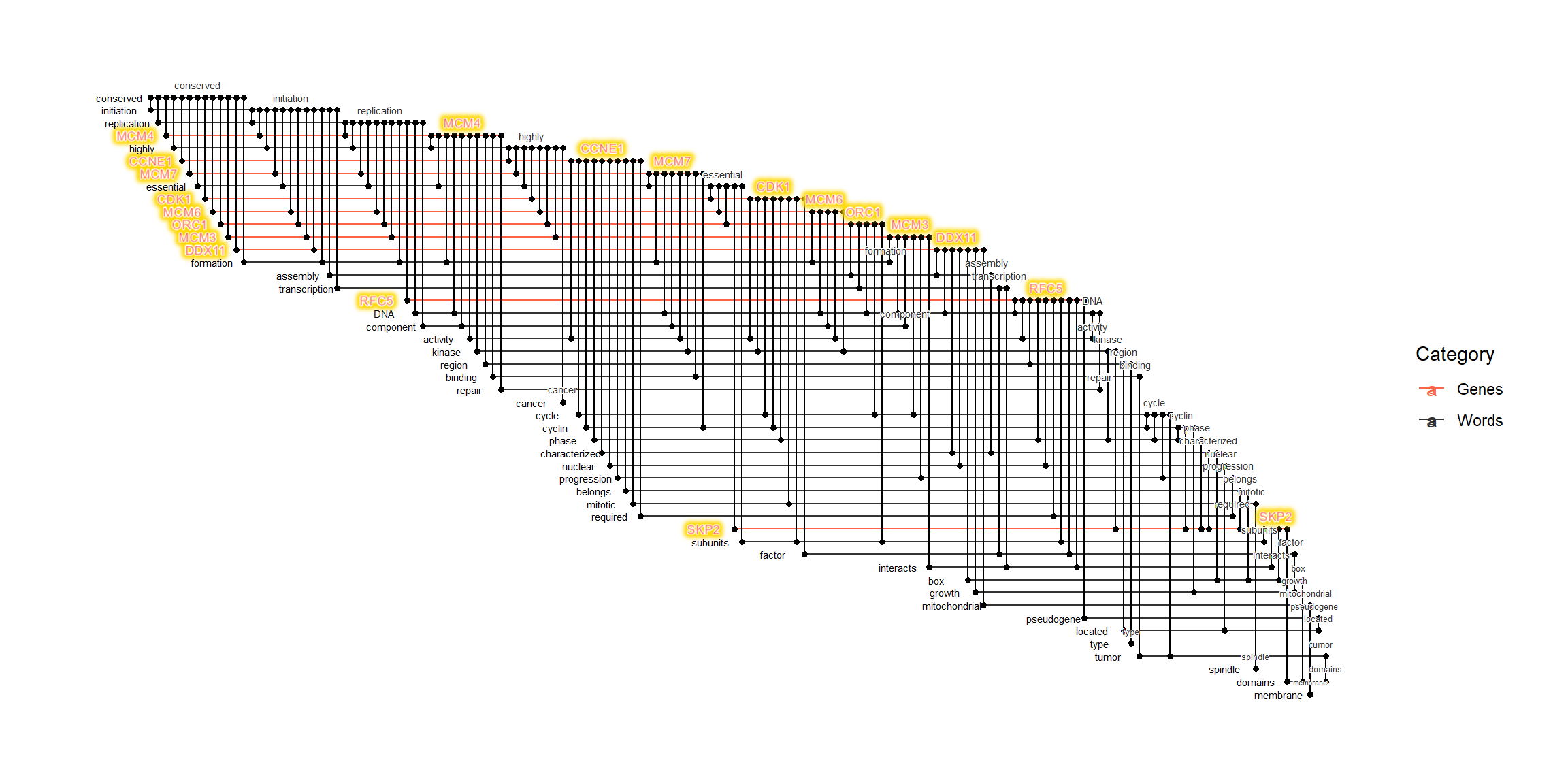
2.9.2 Biofabric layouts for combined networks
Can be used in cojuction with compareWordNet(). The BioFabric layout is especially useful for visualizing complex networks. For interactively inspecting complex networks, please refer to the section 4.3.1.
net1 <- refseq(keggList$`04110`, keyType="ENTREZID",
corThresh=0.3, numWords=30, autoThresh=FALSE)
#> Input genes: 124
#> Filter based on GeneSummary
#> Filtered 77 words (frequency and/or tfidf)
net2 <- refseq(keggList$`04114`, keyType="ENTREZID",
corThresh=0.3, numWords=30, autoThresh=FALSE)
#> Input genes: 112
#> Filter based on GeneSummary
#> Filtered 77 words (frequency and/or tfidf)
comp <- compareWordNet(list(net1, net2),titles=c("4110","4114"))
## Grouping is stored in `col` variable of nodes
ggraph(getSlot(comp, "igraphRaw") |> obtainTextPosition(), "fabric",sort.by=node_rank_fabric())+
geom_node_range() +
geom_edge_span(end_shape = 'circle') +
geom_node_shadowtext(aes(x=.data$xmin-4,
label=.data$name), color="grey20",size=2, bg.colour="white")+
geom_node_shadowtext(aes(x=.data$center,
y=.data$y+1, label=.data$name, color=col), bg.colour="white", size=2)+
theme_graph()
2.9.3 Wrapper for BioFabric layout
The funciton plot_biofabric is prepared, which accepts biotext class object.
ex |> plot_biofabric(end_shape="square")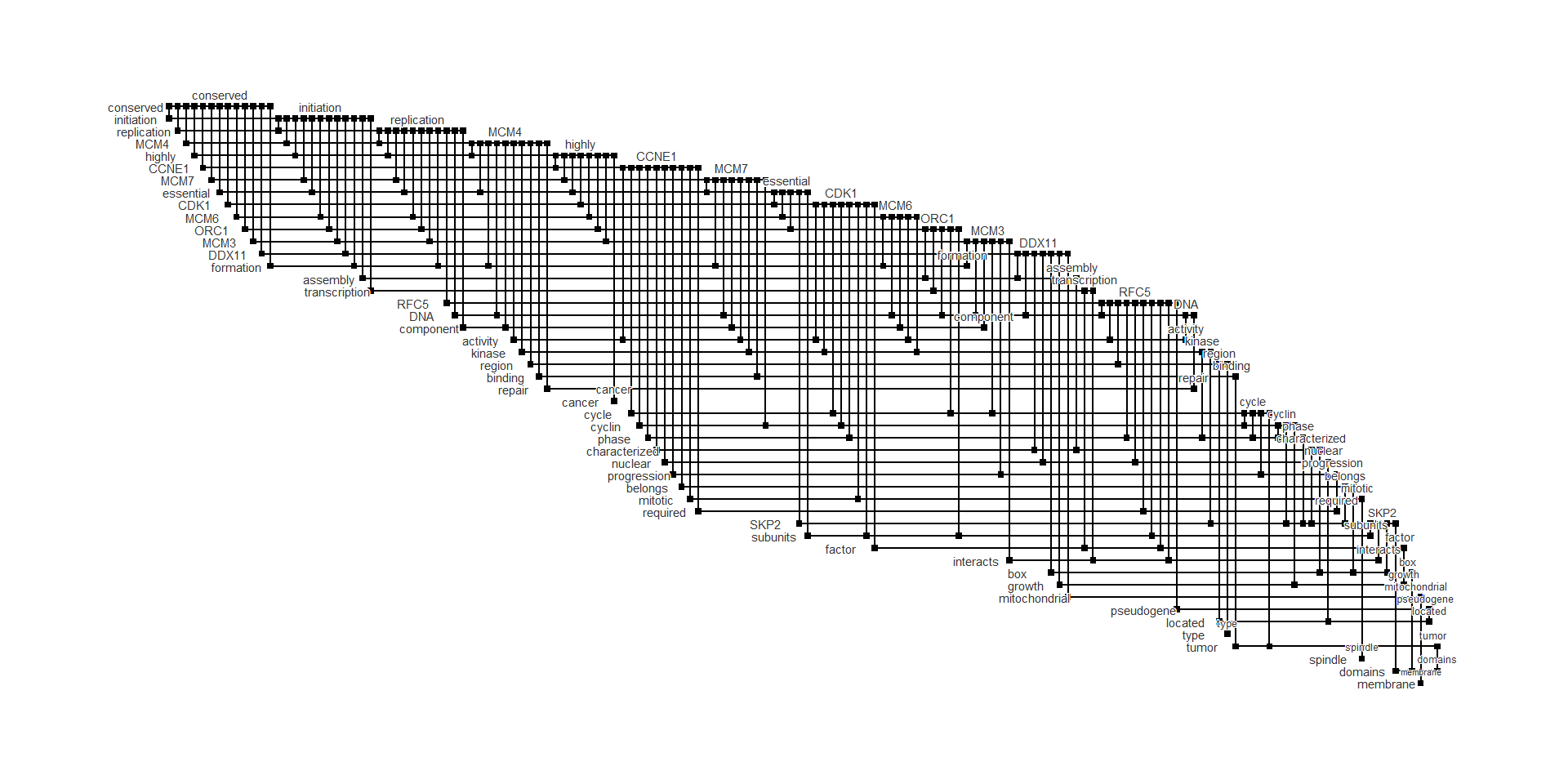
2.10 Dynamic layout
Dynamic layout can be also used to compare the networks, by graphlayouts, for comparing the multiple graphs, especially useful for time-series analysis. See the documentation of layout_as_dynamic for specifying the alpha, which is default to 0.5.
library(igraph)
dyn <- plotDynamic(list(net1, net2), concat="union")
dyn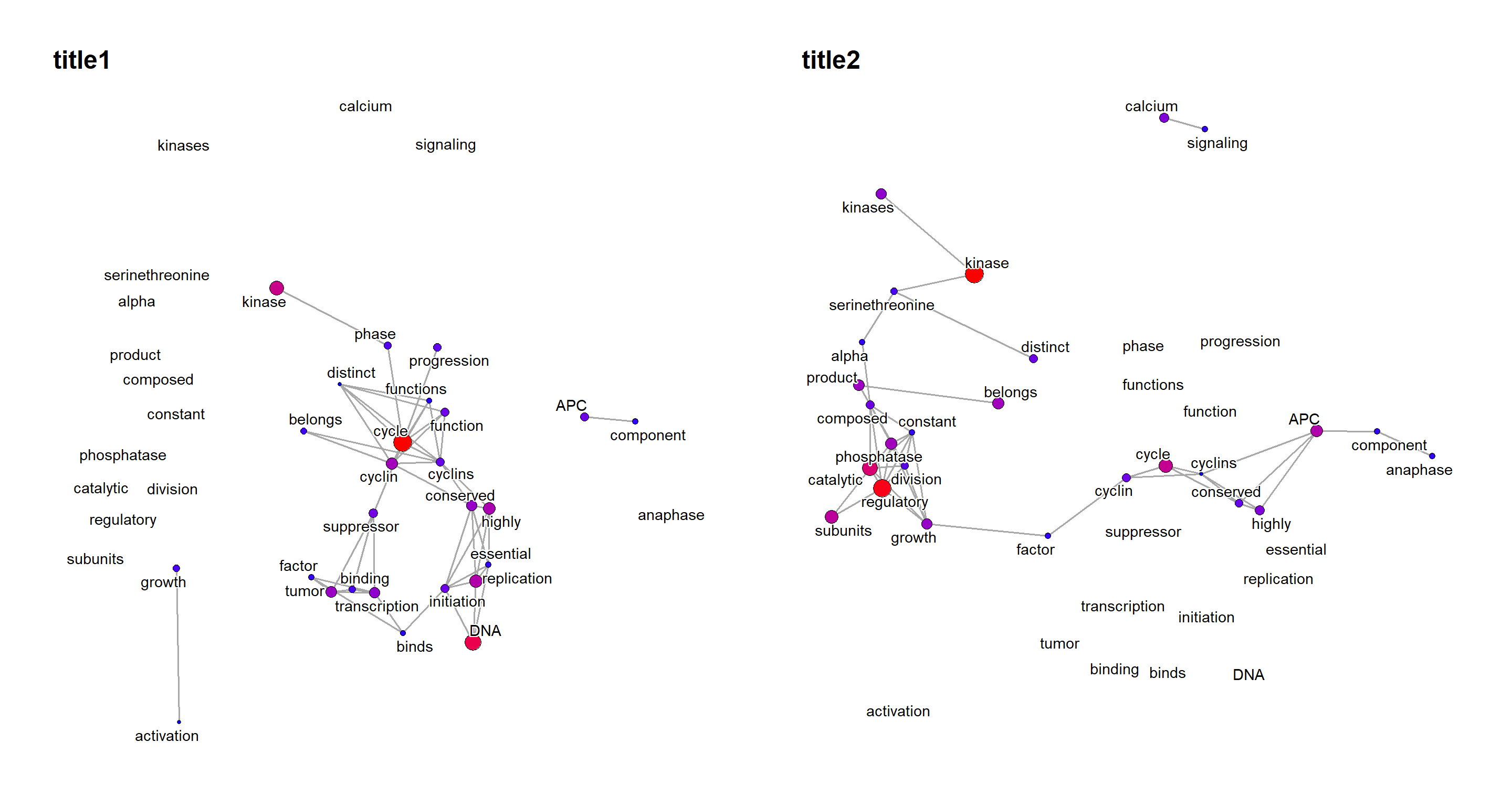
2.11 Input type
Some input types can be used to conveniently perform text mining. refseqWGCNA accepts blockwiseModules() results from WGCNA, and recursively returns the biotext class object for each of the cluster.
load("./blockwiseModule.rda")
test <- refseqWGCNA(bwmod)
#> Processing a total of 17 clusters
#> Input genes: 1066
#> Converted input genes: 885
#> Filter based on GeneSummary
#> Filtered 77 words (frequency and/or tfidf)
#> Ignoring corThresh, automatically determine the value
#> threshold = 0.001
#> Input genes: 2396
#> Converted input genes: 2199
#> Filter based on GeneSummary
#> Filtered 77 words (frequency and/or tfidf)
#> Ignoring corThresh, automatically determine the value
#> threshold = 0
#> Input genes: 12526
#> Converted input genes: 9512
#> Filter based on GeneSummary
#> Filtered 77 words (frequency and/or tfidf)
#> Ignoring corThresh, automatically determine the value
#> threshold = 0
#> Input genes: 5586
#> Converted input genes: 4595
#> Filter based on GeneSummary
#> Filtered 77 words (frequency and/or tfidf)
#> Ignoring corThresh, automatically determine the value
#> threshold = 0
#> Input genes: 181
#> Converted input genes: 168
#> Filter based on GeneSummary
#> Filtered 77 words (frequency and/or tfidf)
#> Ignoring corThresh, automatically determine the value
#> threshold = 0.101
#> Input genes: 379
#> Converted input genes: 338
#> Filter based on GeneSummary
#> Filtered 77 words (frequency and/or tfidf)
#> Ignoring corThresh, automatically determine the value
#> threshold = 0.1
#> Input genes: 774
#> Converted input genes: 626
#> Filter based on GeneSummary
#> Filtered 77 words (frequency and/or tfidf)
#> Ignoring corThresh, automatically determine the value
#> threshold = 0.104
#> Input genes: 147
#> Converted input genes: 126
#> Filter based on GeneSummary
#> Filtered 77 words (frequency and/or tfidf)
#> Ignoring corThresh, automatically determine the value
#> threshold = 0.101
#> Input genes: 87
#> Converted input genes: 85
#> Filter based on GeneSummary
#> Filtered 77 words (frequency and/or tfidf)
#> Ignoring corThresh, automatically determine the value
#> threshold = 0.201
#> Input genes: 94
#> Converted input genes: 92
#> Filter based on GeneSummary
#> Filtered 77 words (frequency and/or tfidf)
#> Ignoring corThresh, automatically determine the value
#> threshold = 0.102
#> Input genes: 113
#> Converted input genes: 104
#> Filter based on GeneSummary
#> Filtered 77 words (frequency and/or tfidf)
#> Ignoring corThresh, automatically determine the value
#> threshold = 0.101
#> Input genes: 83
#> Converted input genes: 77
#> Filter based on GeneSummary
#> Filtered 77 words (frequency and/or tfidf)
#> Ignoring corThresh, automatically determine the value
#> threshold = 0.101
#> Input genes: 233
#> Converted input genes: 141
#> Filter based on GeneSummary
#> Filtered 77 words (frequency and/or tfidf)
#> Ignoring corThresh, automatically determine the value
#> threshold = 0.3
#> Input genes: 68
#> Converted input genes: 67
#> Filter based on GeneSummary
#> Filtered 77 words (frequency and/or tfidf)
#> Ignoring corThresh, automatically determine the value
#> threshold = 0.2
#> Input genes: 45
#> Converted input genes: 45
#> Filter based on GeneSummary
#> Filtered 77 words (frequency and/or tfidf)
#> Ignoring corThresh, automatically determine the value
#> threshold = 0
#> Input genes: 86
#> Converted input genes: 47
#> Filter based on GeneSummary
#> Filtered 77 words (frequency and/or tfidf)
#> Ignoring corThresh, automatically determine the value
#> threshold = 0.2
#> Input genes: 36
#> Converted input genes: 9
#> Filter based on GeneSummary
#> Filtered 77 words (frequency and/or tfidf)
#> Error in cor(x = c(`2024` = 1, `70nt` = 1, antisense = 1, base = 1, capped = 1, :
#> supply both 'x' and 'y' or a matrix-like 'x'
length(test)
#> [1] 17
test[[1]]@net + test[[2]]@net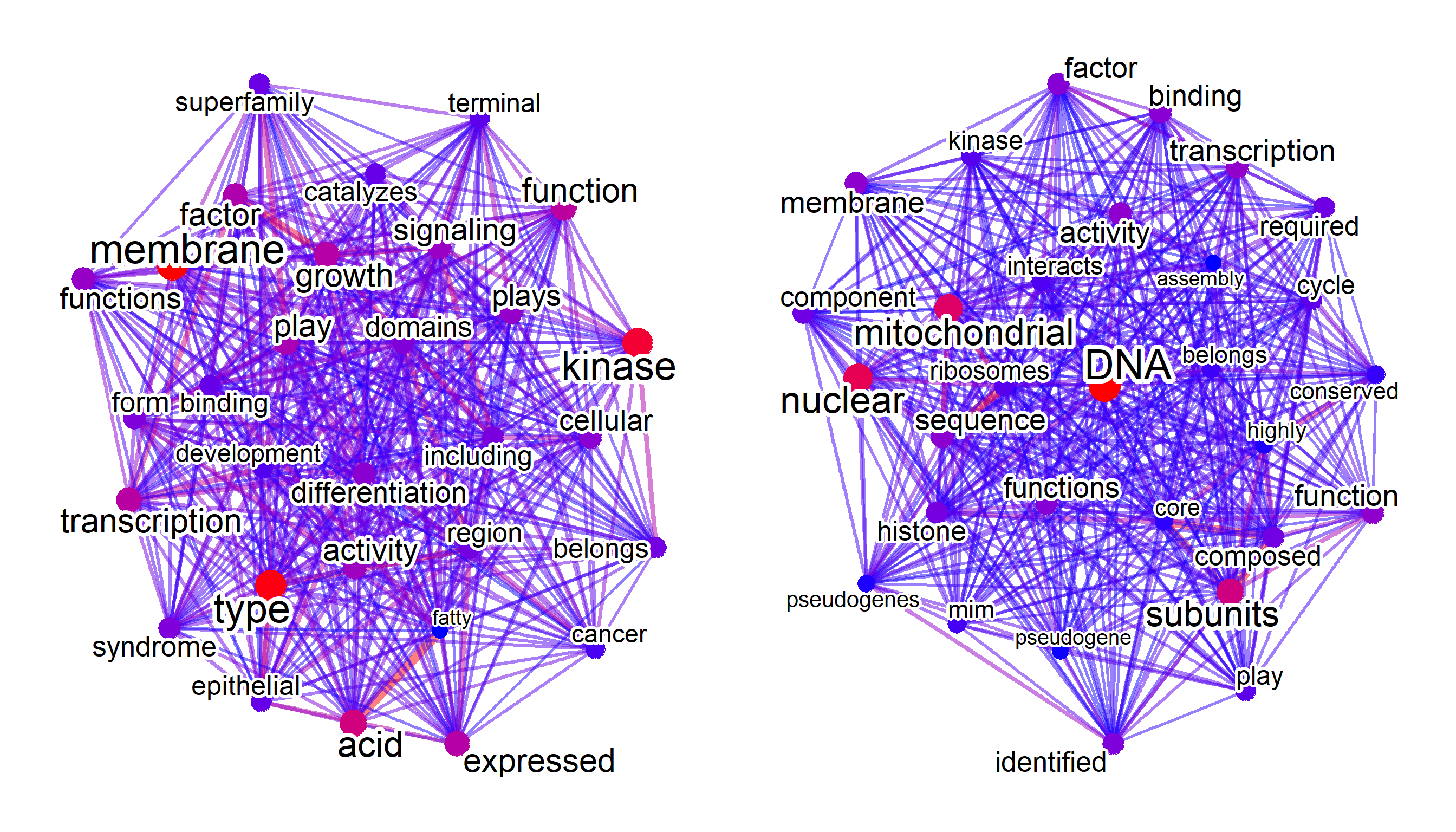
refseqDESeq2 accepts the resulting object from DESeq2::results() function, with specified criteria such as LFC and p-values and returns the biotext class object like as follows.
library(DESeq2)
library(org.Hs.eg.db)
dds <- makeExampleDESeqDataSet(m=4)
dds <- DESeq(dds)
res <- results(dds, contrast=c("condition","B","A"))
set.seed(123)
row.names(res) <- sample(keys(org.Hs.eg.db, "ENSEMBL"), nrow(res))
res
#> log2 fold change (MLE): condition B vs A
#> Wald test p-value: condition B vs A
#> DataFrame with 1000 rows and 6 columns
#> baseMean log2FoldChange lfcSE
#> <numeric> <numeric> <numeric>
#> ENSG00000173801 30.616784 0.9499853 0.794602
#> ENSG00000265789 21.514495 0.1038858 1.024781
#> ENSG00000249531 0.750854 3.0643242 4.855112
#> ENSG00000202358 51.533085 0.0681512 0.666996
#> ENSG00000119912 6.392006 -0.6407534 1.733944
#> ... ... ... ...
#> ENSG00000274518 88.69205 -0.0515992 0.581795
#> ENSG00000104154 11.28361 0.3631596 1.243822
#> ENSG00000148841 13.49360 -0.2693230 1.104549
#> ENSG00000202283 5.38738 -0.2669877 1.608832
#> ENSG00000106261 41.40248 0.2672459 0.689372
#> stat pvalue padj
#> <numeric> <numeric> <numeric>
#> ENSG00000173801 1.195548 0.231873 0.999624
#> ENSG00000265789 0.101374 0.919254 0.999624
#> ENSG00000249531 0.631154 0.527940 0.999624
#> ENSG00000202358 0.102176 0.918617 0.999624
#> ENSG00000119912 -0.369535 0.711729 0.999624
#> ... ... ... ...
#> ENSG00000274518 -0.0886896 0.929329 0.999624
#> ENSG00000104154 0.2919706 0.770309 0.999624
#> ENSG00000148841 -0.2438306 0.807362 0.999624
#> ENSG00000202283 -0.1659513 0.868195 0.999624
#> ENSG00000106261 0.3876656 0.698264 0.999624
refseqDESeq2(res, log2FoldChange>2) |> plotNet(asis=TRUE)
#> Input genes: 58
#> Converted input genes: 59
#> Filter based on GeneSummary
#> Filtered 77 words (frequency and/or tfidf)
#> Ignoring corThresh, automatically determine the value
#> threshold = 0.303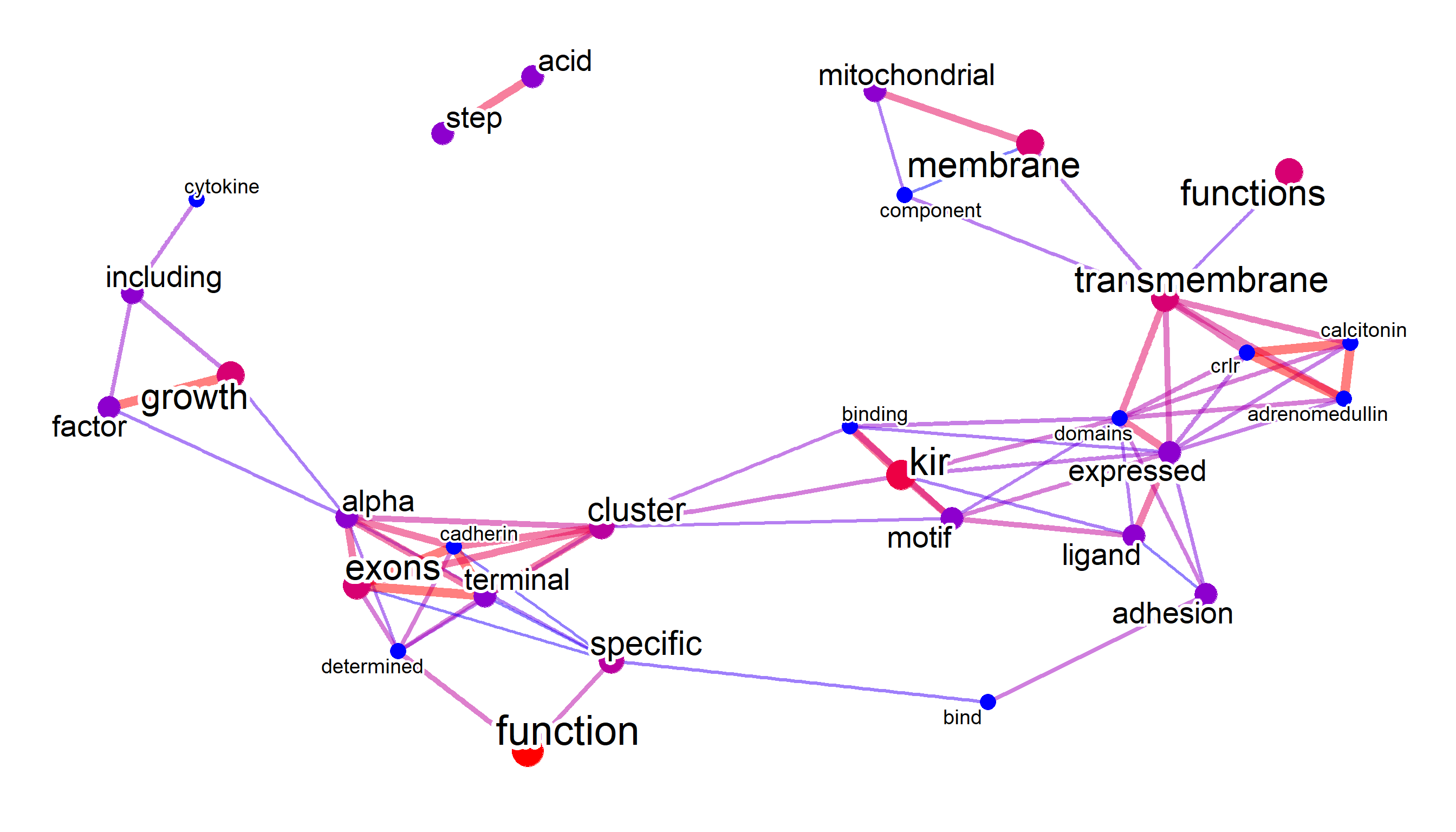
2.12 Split by EA
If splitByEA option is enabled, the function first performs enrichment analysis on the queried input, and output the list of biotext object for each significant pathway, as well as for those not related to significant pathways. This is useful for confirming the prior knowledge in terms of textual information perspective.
eanets <- refseq(inpSymbol, splitByEA="reactome")
#> Total of 48 pathways, including non-enrichment terms
#> Input genes: 7
#> Filter based on GeneSummary
#> Filtered 77 words (frequency and/or tfidf)
#> Ignoring corThresh, automatically determine the value
#> threshold = 0.5
#> Input genes: 7
#> Filter based on GeneSummary
#> Filtered 77 words (frequency and/or tfidf)
#> Ignoring corThresh, automatically determine the value
#> threshold = 0.5
#> Input genes: 7
#> Filter based on GeneSummary
#> Filtered 77 words (frequency and/or tfidf)
#> Ignoring corThresh, automatically determine the value
#> threshold = 0.5
#> Input genes: 5
#> Filter based on GeneSummary
#> Filtered 77 words (frequency and/or tfidf)
#> Ignoring corThresh, automatically determine the value
#> threshold = 0.7
#> Input genes: 5
#> Filter based on GeneSummary
#> Filtered 77 words (frequency and/or tfidf)
#> Ignoring corThresh, automatically determine the value
#> threshold = 0.7
#> Input genes: 7
#> Filter based on GeneSummary
#> Filtered 77 words (frequency and/or tfidf)
#> Ignoring corThresh, automatically determine the value
#> threshold = 0.5
#> Input genes: 5
#> Filter based on GeneSummary
#> Filtered 77 words (frequency and/or tfidf)
#> Ignoring corThresh, automatically determine the value
#> threshold = 0.7
#> Input genes: 4
#> Filter based on GeneSummary
#> Filtered 77 words (frequency and/or tfidf)
#> Ignoring corThresh, automatically determine the value
#> threshold = 0.8
#> Input genes: 4
#> Filter based on GeneSummary
#> Filtered 77 words (frequency and/or tfidf)
#> Ignoring corThresh, automatically determine the value
#> threshold = 0.8
#> Input genes: 3
#> Filter based on GeneSummary
#> Filtered 77 words (frequency and/or tfidf)
#> Ignoring corThresh, automatically determine the value
#> threshold = 1
#> Input genes: 3
#> Filter based on GeneSummary
#> Filtered 77 words (frequency and/or tfidf)
#> Ignoring corThresh, automatically determine the value
#> threshold = 1
#> Input genes: 3
#> Filter based on GeneSummary
#> Filtered 77 words (frequency and/or tfidf)
#> Ignoring corThresh, automatically determine the value
#> threshold = 1
#> Input genes: 2
#> Filter based on GeneSummary
#> Filtered 77 words (frequency and/or tfidf)
#> Ignoring corThresh, automatically determine the value
#> threshold = 1
#> Input genes: 2
#> Filter based on GeneSummary
#> Filtered 77 words (frequency and/or tfidf)
#> Ignoring corThresh, automatically determine the value
#> threshold = 1
#> Input genes: 2
#> Filter based on GeneSummary
#> Filtered 77 words (frequency and/or tfidf)
#> Ignoring corThresh, automatically determine the value
#> threshold = 1
#> Input genes: 3
#> Filter based on GeneSummary
#> Filtered 77 words (frequency and/or tfidf)
#> Ignoring corThresh, automatically determine the value
#> threshold = 1
#> Input genes: 2
#> Filter based on GeneSummary
#> Filtered 77 words (frequency and/or tfidf)
#> Ignoring corThresh, automatically determine the value
#> threshold = 1
#> Input genes: 2
#> Filter based on GeneSummary
#> Filtered 77 words (frequency and/or tfidf)
#> Ignoring corThresh, automatically determine the value
#> threshold = 1
#> Input genes: 2
#> Filter based on GeneSummary
#> Filtered 77 words (frequency and/or tfidf)
#> Ignoring corThresh, automatically determine the value
#> threshold = 1
#> Input genes: 2
#> Filter based on GeneSummary
#> Filtered 77 words (frequency and/or tfidf)
#> Ignoring corThresh, automatically determine the value
#> threshold = 1
#> Input genes: 2
#> Filter based on GeneSummary
#> Filtered 77 words (frequency and/or tfidf)
#> Ignoring corThresh, automatically determine the value
#> threshold = 1
#> Input genes: 2
#> Filter based on GeneSummary
#> Filtered 77 words (frequency and/or tfidf)
#> Ignoring corThresh, automatically determine the value
#> threshold = 1
#> Input genes: 2
#> Filter based on GeneSummary
#> Filtered 77 words (frequency and/or tfidf)
#> Ignoring corThresh, automatically determine the value
#> threshold = 1
#> Input genes: 2
#> Filter based on GeneSummary
#> Filtered 77 words (frequency and/or tfidf)
#> Ignoring corThresh, automatically determine the value
#> threshold = 1
#> Input genes: 2
#> Filter based on GeneSummary
#> Filtered 77 words (frequency and/or tfidf)
#> Ignoring corThresh, automatically determine the value
#> threshold = 1
#> Input genes: 2
#> Filter based on GeneSummary
#> Filtered 77 words (frequency and/or tfidf)
#> Ignoring corThresh, automatically determine the value
#> threshold = 1
#> Input genes: 2
#> Filter based on GeneSummary
#> Filtered 77 words (frequency and/or tfidf)
#> Ignoring corThresh, automatically determine the value
#> threshold = 1
#> Input genes: 2
#> Filter based on GeneSummary
#> Filtered 77 words (frequency and/or tfidf)
#> Ignoring corThresh, automatically determine the value
#> threshold = 1
#> Input genes: 2
#> Filter based on GeneSummary
#> Filtered 77 words (frequency and/or tfidf)
#> Ignoring corThresh, automatically determine the value
#> threshold = 1
#> Input genes: 2
#> Filter based on GeneSummary
#> Filtered 77 words (frequency and/or tfidf)
#> Ignoring corThresh, automatically determine the value
#> threshold = 1
#> Input genes: 2
#> Filter based on GeneSummary
#> Filtered 77 words (frequency and/or tfidf)
#> Ignoring corThresh, automatically determine the value
#> threshold = 1
#> Input genes: 2
#> Filter based on GeneSummary
#> Filtered 77 words (frequency and/or tfidf)
#> Ignoring corThresh, automatically determine the value
#> threshold = 1
#> Input genes: 2
#> Filter based on GeneSummary
#> Filtered 77 words (frequency and/or tfidf)
#> Ignoring corThresh, automatically determine the value
#> threshold = 1
#> Input genes: 2
#> Filter based on GeneSummary
#> Filtered 77 words (frequency and/or tfidf)
#> Ignoring corThresh, automatically determine the value
#> threshold = 1
#> Input genes: 2
#> Filter based on GeneSummary
#> Filtered 77 words (frequency and/or tfidf)
#> Ignoring corThresh, automatically determine the value
#> threshold = 1
#> Input genes: 2
#> Filter based on GeneSummary
#> Filtered 77 words (frequency and/or tfidf)
#> Ignoring corThresh, automatically determine the value
#> threshold = 1
#> Input genes: 2
#> Filter based on GeneSummary
#> Filtered 77 words (frequency and/or tfidf)
#> Ignoring corThresh, automatically determine the value
#> threshold = 1
#> Input genes: 2
#> Filter based on GeneSummary
#> Filtered 77 words (frequency and/or tfidf)
#> Ignoring corThresh, automatically determine the value
#> threshold = 1
#> Input genes: 2
#> Filter based on GeneSummary
#> Filtered 77 words (frequency and/or tfidf)
#> Ignoring corThresh, automatically determine the value
#> threshold = 1
#> Input genes: 2
#> Filter based on GeneSummary
#> Filtered 77 words (frequency and/or tfidf)
#> Ignoring corThresh, automatically determine the value
#> threshold = 1
#> Input genes: 2
#> Filter based on GeneSummary
#> Filtered 77 words (frequency and/or tfidf)
#> Ignoring corThresh, automatically determine the value
#> threshold = 1
#> Input genes: 2
#> Filter based on GeneSummary
#> Filtered 77 words (frequency and/or tfidf)
#> Ignoring corThresh, automatically determine the value
#> threshold = 1
#> Input genes: 2
#> Filter based on GeneSummary
#> Filtered 77 words (frequency and/or tfidf)
#> Ignoring corThresh, automatically determine the value
#> threshold = 1
#> Input genes: 2
#> Filter based on GeneSummary
#> Filtered 77 words (frequency and/or tfidf)
#> Ignoring corThresh, automatically determine the value
#> threshold = 1
#> Input genes: 2
#> Filter based on GeneSummary
#> Filtered 77 words (frequency and/or tfidf)
#> Ignoring corThresh, automatically determine the value
#> threshold = 1
#> Input genes: 2
#> Filter based on GeneSummary
#> Filtered 77 words (frequency and/or tfidf)
#> Ignoring corThresh, automatically determine the value
#> threshold = 1
plotNet(eanets[[1]], asis=TRUE)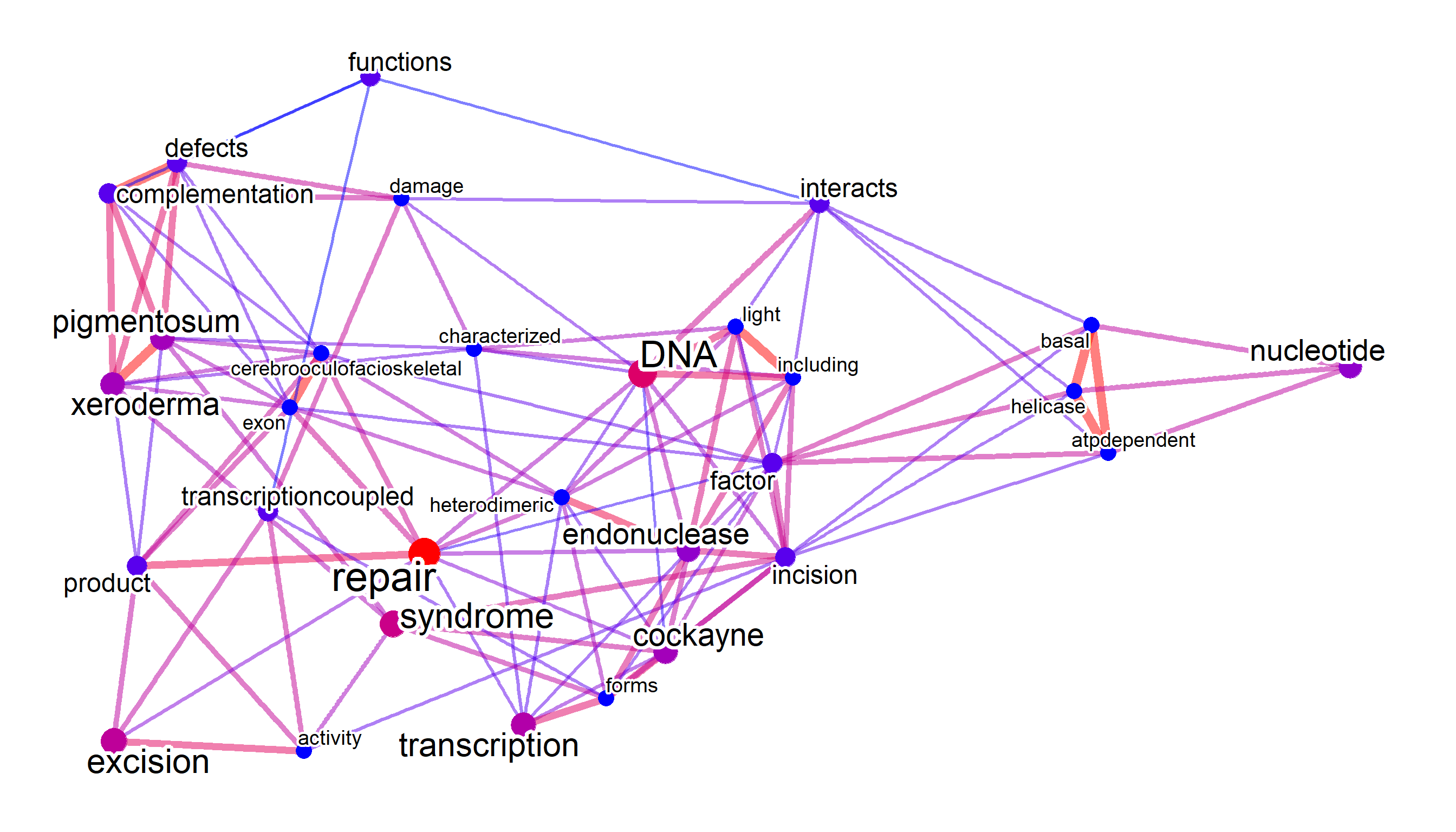
sessionInfo()
#> R version 4.3.1 (2023-06-16 ucrt)
#> Platform: x86_64-w64-mingw32/x64 (64-bit)
#> Running under: Windows 11 x64 (build 22621)
#>
#> Matrix products: default
#>
#>
#> locale:
#> [1] LC_COLLATE=Japanese_Japan.utf8
#> [2] LC_CTYPE=Japanese_Japan.utf8
#> [3] LC_MONETARY=Japanese_Japan.utf8
#> [4] LC_NUMERIC=C
#> [5] LC_TIME=Japanese_Japan.utf8
#>
#> time zone: Asia/Tokyo
#> tzcode source: internal
#>
#> attached base packages:
#> [1] stats4 stats graphics grDevices utils
#> [6] datasets methods base
#>
#> other attached packages:
#> [1] ggkegg_1.0.7 DESeq2_1.41.10
#> [3] SummarizedExperiment_1.31.1 MatrixGenerics_1.13.1
#> [5] matrixStats_1.0.0 GenomicRanges_1.53.1
#> [7] GenomeInfoDb_1.37.4 testthat_3.1.10
#> [9] XML_3.99-0.14 tidygraph_1.2.3
#> [11] ggfx_1.0.1 igraph_1.5.1
#> [13] GetoptLong_1.0.5 ggrepel_0.9.5
#> [15] scales_1.3.0 ggforce_0.4.1
#> [17] concaveman_1.1.0 dplyr_1.1.4
#> [19] dendextend_1.17.1 clusterProfiler_4.9.5
#> [21] ReactomePA_1.46.0 RColorBrewer_1.1-3
#> [23] ggraph_2.1.0.9000 org.Hs.eg.db_3.17.0
#> [25] AnnotationDbi_1.63.2 IRanges_2.35.2
#> [27] S4Vectors_0.38.1 Biobase_2.61.0
#> [29] BiocGenerics_0.47.0 biotextgraph_0.99.0
#> [31] ggplot2_3.4.4
#>
#> loaded via a namespace (and not attached):
#> [1] fs_1.6.3
#> [2] bitops_1.0-7
#> [3] enrichplot_1.21.3
#> [4] devtools_2.4.5
#> [5] HDO.db_0.99.1
#> [6] httr_1.4.7
#> [7] profvis_0.3.8
#> [8] tools_4.3.1
#> [9] utf8_1.2.3
#> [10] R6_2.5.1
#> [11] lazyeval_0.2.2
#> [12] urlchecker_1.0.1
#> [13] withr_2.5.0
#> [14] prettyunits_1.1.1
#> [15] graphite_1.48.0
#> [16] gridExtra_2.3
#> [17] downlit_0.4.3
#> [18] cli_3.6.1
#> [19] textshaping_0.3.6
#> [20] Cairo_1.6-1
#> [21] scatterpie_0.2.1
#> [22] labeling_0.4.3
#> [23] slam_0.1-50
#> [24] sass_0.4.7
#> [25] tm_0.7-11
#> [26] systemfonts_1.0.4
#> [27] commonmark_1.9.0
#> [28] yulab.utils_0.1.0
#> [29] gson_0.1.0
#> [30] DOSE_3.27.2
#> [31] rentrez_1.2.3
#> [32] showtext_0.9-6
#> [33] sessioninfo_1.2.2
#> [34] rstudioapi_0.15.0
#> [35] sysfonts_0.8.8
#> [36] RSQLite_2.3.1
#> [37] generics_0.1.3
#> [38] gridGraphics_0.5-1
#> [39] GO.db_3.17.0
#> [40] Matrix_1.6-5
#> [41] pvclust_2.2-0
#> [42] fansi_1.0.4
#> [43] abind_1.4-5
#> [44] lifecycle_1.0.3
#> [45] yaml_2.3.7
#> [46] qvalue_2.33.0
#> [47] SparseArray_1.1.12
#> [48] BiocFileCache_2.9.1
#> [49] cyjShiny_1.0.42
#> [50] grid_4.3.1
#> [51] blob_1.2.4
#> [52] promises_1.2.1
#> [53] crayon_1.5.2
#> [54] miniUI_0.1.1.1
#> [55] lattice_0.21-8
#> [56] cowplot_1.1.1
#> [57] KEGGREST_1.41.0
#> [58] magick_2.7.5
#> [59] pillar_1.9.0
#> [60] knitr_1.44
#> [61] fgsea_1.27.1
#> [62] rjson_0.2.21
#> [63] stopwords_2.3
#> [64] codetools_0.2-19
#> [65] fastmatch_1.1-4
#> [66] glue_1.6.2
#> [67] ggfun_0.1.3
#> [68] remotes_2.4.2.1
#> [69] data.table_1.14.8
#> [70] vctrs_0.6.5
#> [71] png_0.1-8
#> [72] treeio_1.25.4
#> [73] gtable_0.3.4
#> [74] cachem_1.0.8
#> [75] xfun_0.40
#> [76] S4Arrays_1.1.6
#> [77] mime_0.12
#> [78] showtextdb_3.0
#> [79] ISOcodes_2022.09.29
#> [80] interactiveDisplayBase_1.39.0
#> [81] ellipsis_0.3.2
#> [82] GeneSummary_0.99.6
#> [83] nlme_3.1-163
#> [84] usethis_2.2.2
#> [85] ggtree_3.9.1
#> [86] bit64_4.0.5
#> [87] filelock_1.0.2
#> [88] rprojroot_2.0.3
#> [89] ggwordcloud_0.6.0
#> [90] bslib_0.5.1
#> [91] colorspace_2.1-0
#> [92] DBI_1.1.3
#> [93] processx_3.8.2
#> [94] tidyselect_1.2.0
#> [95] bit_4.0.5
#> [96] compiler_4.3.1
#> [97] curl_5.0.2
#> [98] graph_1.79.1
#> [99] xml2_1.3.5
#> [100] NLP_0.2-1
#> [101] desc_1.4.2
#> [102] ggdendro_0.1.23
#> [103] DelayedArray_0.27.10
#> [104] bookdown_0.35
#> [105] shadowtext_0.1.2
#> [106] callr_3.7.3
#> [107] rappdirs_0.3.3
#> [108] stringr_1.5.0
#> [109] digest_0.6.33
#> [110] rmarkdown_2.25
#> [111] XVector_0.41.1
#> [112] htmltools_0.5.6
#> [113] pkgconfig_2.0.3
#> [114] base64enc_0.1-3
#> [115] dbplyr_2.3.3
#> [116] fastmap_1.1.1
#> [117] rlang_1.1.1
#> [118] GlobalOptions_0.1.2
#> [119] htmlwidgets_1.6.2
#> [120] shiny_1.7.5
#> [121] farver_2.1.1
#> [122] jquerylib_0.1.4
#> [123] jsonlite_1.8.7
#> [124] BiocParallel_1.35.4
#> [125] GOSemSim_2.27.3
#> [126] RCurl_1.98-1.12
#> [127] magrittr_2.0.3
#> [128] GenomeInfoDbData_1.2.10
#> [129] ggplotify_0.1.2
#> [130] wordcloud_2.6
#> [131] patchwork_1.2.0
#> [132] munsell_0.5.0
#> [133] Rcpp_1.0.11
#> [134] ape_5.7-1
#> [135] viridis_0.6.4
#> [136] stringi_1.7.12
#> [137] brio_1.1.3
#> [138] zlibbioc_1.47.0
#> [139] MASS_7.3-60
#> [140] AnnotationHub_3.9.2
#> [141] plyr_1.8.8
#> [142] pkgbuild_1.4.2
#> [143] parallel_4.3.1
#> [144] HPO.db_0.99.2
#> [145] bugsigdbr_1.8.1
#> [146] Biostrings_2.69.2
#> [147] graphlayouts_1.0.0
#> [148] splines_4.3.1
#> [149] gridtext_0.1.5
#> [150] locfit_1.5-9.8
#> [151] ps_1.7.5
#> [152] markdown_1.8
#> [153] pkgload_1.3.2.1
#> [154] reshape2_1.4.4
#> [155] BiocVersion_3.18.0
#> [156] evaluate_0.21
#> [157] BiocManager_1.30.22
#> [158] tweenr_2.0.2
#> [159] httpuv_1.6.11
#> [160] tidyr_1.3.0
#> [161] purrr_1.0.2
#> [162] polyclip_1.10-4
#> [163] xtable_1.8-4
#> [164] reactome.db_1.86.0
#> [165] tidytree_0.4.5
#> [166] MPO.db_0.99.7
#> [167] later_1.3.1
#> [168] viridisLite_0.4.2
#> [169] ragg_1.2.5
#> [170] snow_0.4-4
#> [171] tibble_3.2.1
#> [172] aplot_0.2.1
#> [173] memoise_2.0.1